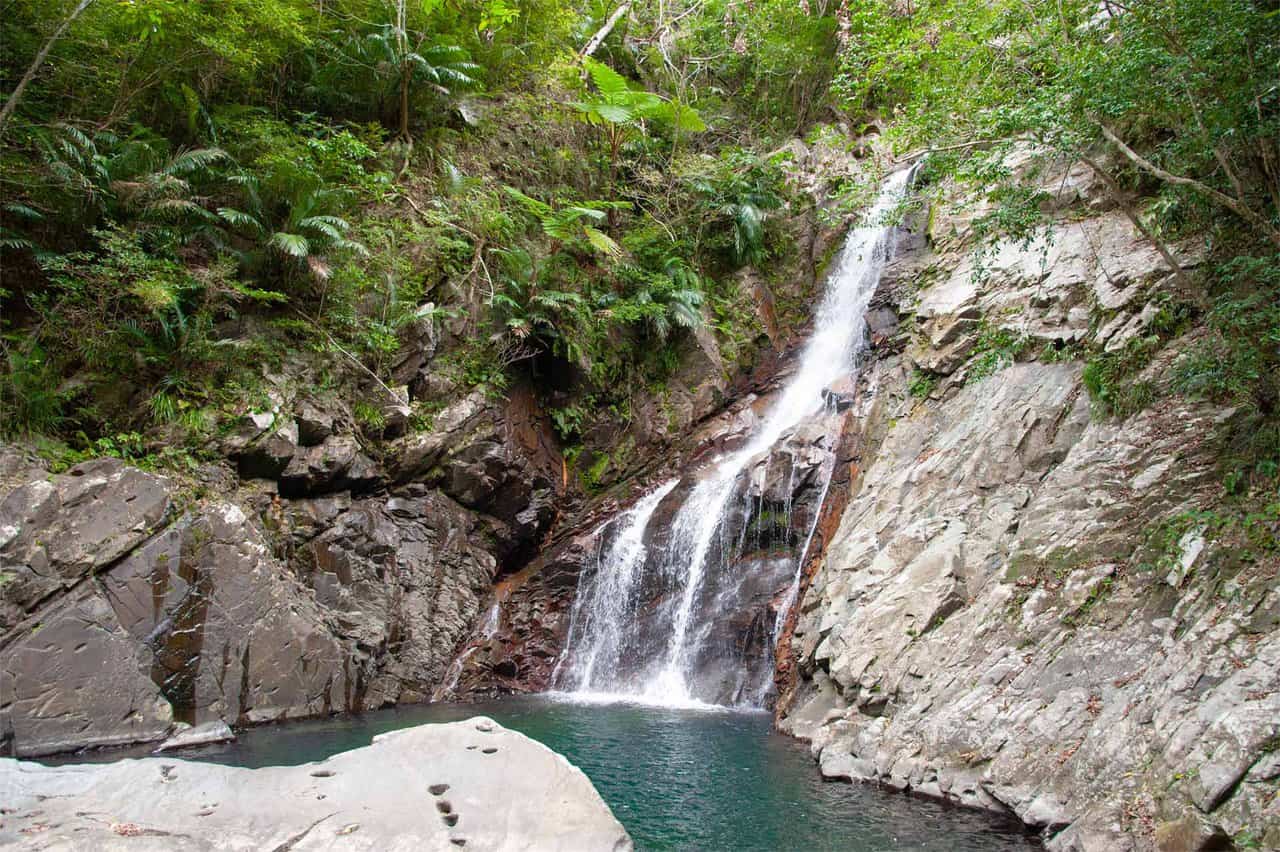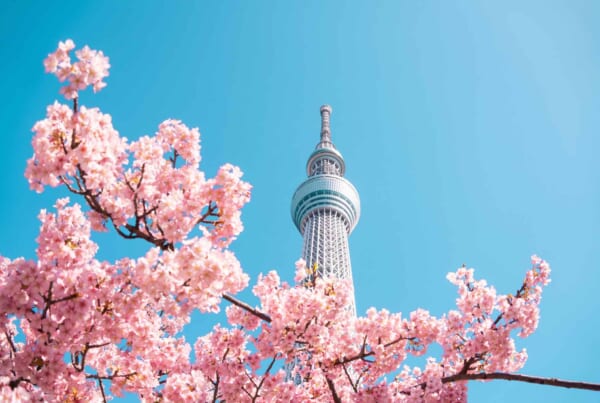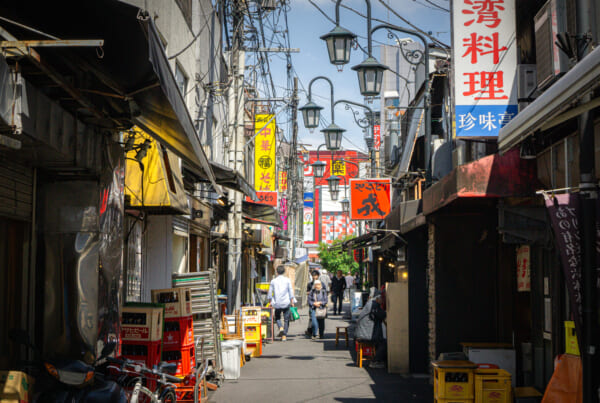ℹ Advertorial
A country of fascinating traditions and incredible culture, as well as breathtaking natural beauty, there is so much to see and do in Japan. One way to explore more of Japan’s many wonders is by visiting two different destinations during a single trip, as I recently did when I spent a few days in Tokyo before flying to the island of Okinawa.
In Tokyo, I discovered how the traditions of Japan’s Edo period still thrive alongside cutting-edge modern contemporary art and culture. Then, over a few days in Okinawa, I learnt about the many aspects of the island’s rich Ryukyu heritage and history. I also got to see some of its stunning natural beauty and sample plenty of sensational traditional Okinawan food.
- How to Travel Between Okinawa and Tokyo
- Day 1 – Exploring the Old and the New in Tokyo
- Admiring World-Famous Woodblock Prints at the Sumida Hokusai Museum
- Stunning Sensoji – Tokyo’s Oldest Temple
- Souvenir Shopping on Nakamise-Dori
- Exploring the Heart of Sensoji Temple
- A Tempura Lunch at Aoi Marushin
- Walking the Charming Streets of Yanaka
- Sensational Night Views of Tokyo from SHIBUYA SKY
- Check in at the La Vista Tokyo Bay
- Day Two in Tokyo – An Early Start at Toyosu Market
- Day 3 – An Easy Flight from Tokyo to Okinawa
- Day 4 – A Morning in Naha Before Moving North
- Day 5 – A Morning Hike to Hiji Otaki Falls
- How to Fly the Happy Route From Canada to Tokyo and Okinawa
How to Travel Between Okinawa and Tokyo
It’s never been easier to plan a trip to Japan that combines several days in Tokyo with a visit to Okinawa. There are dozens of daily flights between Tokyo’s Haneda Airport and Naha, the capital of Okinawa Prefecture. The flight time is a little under three hours, around the same amount of time it takes to travel from Tokyo to Kyoto by bullet train.
Day 1 – Exploring the Old and the New in Tokyo
My trip began with a few days in Tokyo, a city of constant change where you can still enjoy so many of Japan’s age-old traditions.
Admiring World-Famous Woodblock Prints at the Sumida Hokusai Museum
I started my trip in Tokyo in the east of the city at the Sumida Hokusai Museum (すみだ北斎美術館). Dedicated to one of Japan’s famous ukiyo-e artists, Katsushika Hokusai, the museum is located in Ryogoku, the area where Hokusai spent most of his life.
The first thing to notice on arriving at the Sumida Hokusai Museum is the building’s stunning architecture. Designed by the renowned Japanese architect Kazuyo Sejima, the inventive and modern design resembles a shiny distorted cube. Slits in the building’s design form the entrance to the building, with sunlight sparkling off the museum’s silver panels.
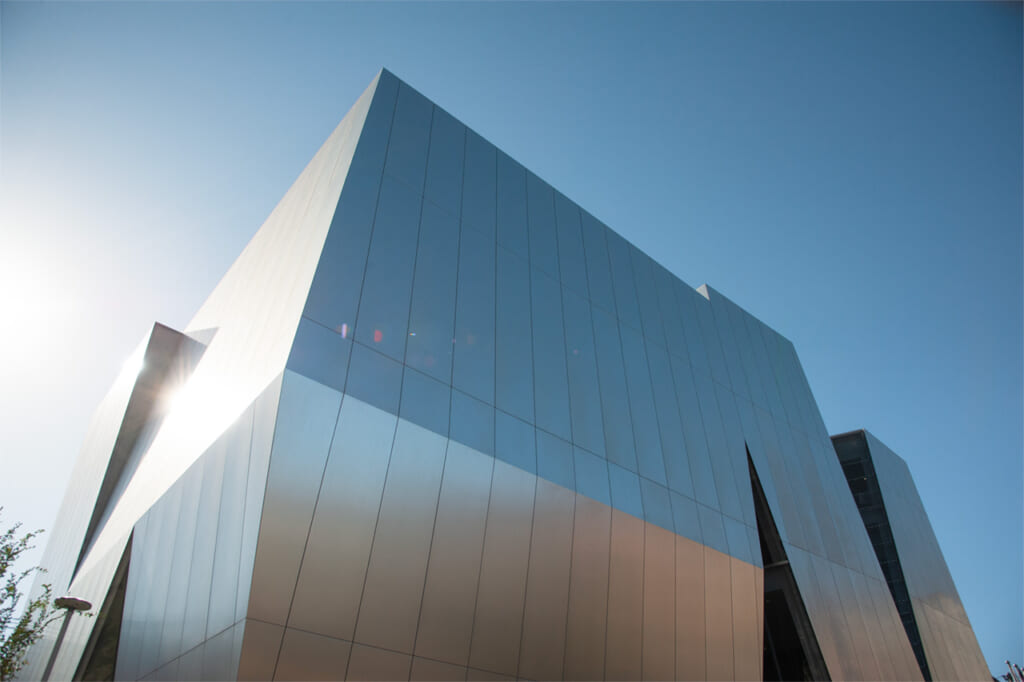
Inside, the Sumida Hokusai Museum holds a permanent collection of many of Hokusai’s most famous works, including Under the Wave Off Kanagawa and A Mild Breeze on a Fine Day. Hokusai’s original woodblock prints are far too delicate to exhibit, so the museum’s permanent collection features exact digital reproductions of the artist’s works.
The permanent exhibition also documents Hokusai’s long and eventful life as well as his prolific career. Touch screens reveal the meanings behind many of Hokusai’s works, and also allow a closer look at some of the finer details of his drawings, paintings and prints.
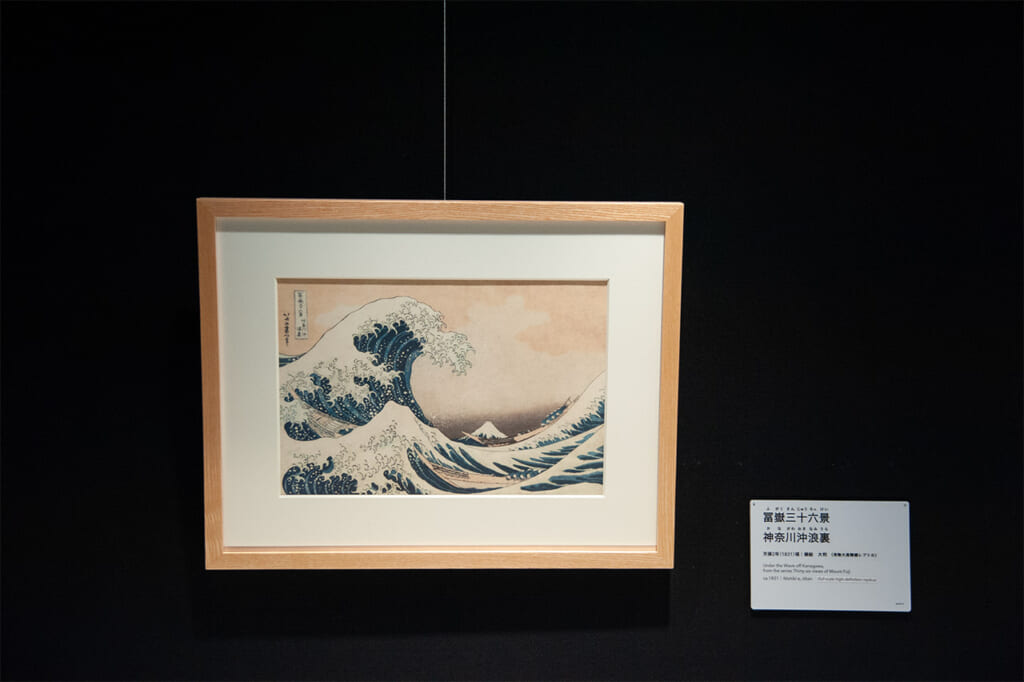
As well as the permanent collection, the museum also holds themed special exhibitions of original prints of Hokusai’s works several times a year. Recent special exhibitions have displayed works by Hokusai and his students based on several recurring themes, including mountains, birds, and the subject of laughter.
Stunning Sensoji – Tokyo’s Oldest Temple
Next, I made my way to the area of Asakusa to visit Sensoji Temple (浅草寺). Sensoji Temple was originally built in 628 to house a statue of Buddha that two brothers discovered while fishing in the nearby Sumida River. Today, Sensoji Temple consists of several grand buildings and gates and is the oldest and most famous temple in Tokyo.
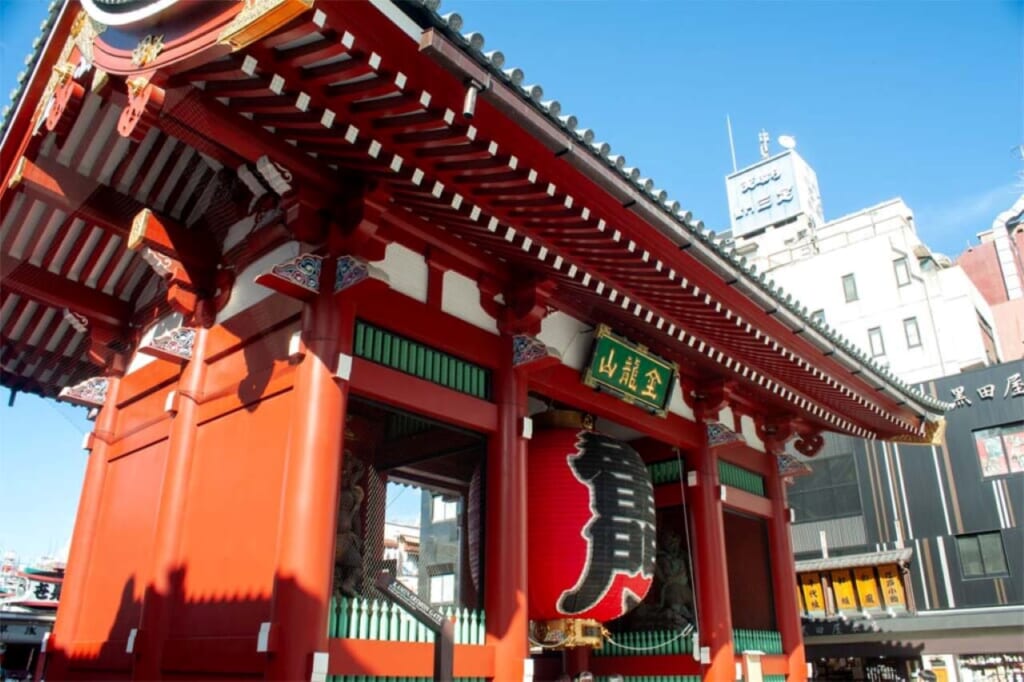
At the entrance of Sensoji Temple is one of Tokyo’s most famous landmarks, the imposing Kaminarimon Gate. The giant gate houses two statues of the God of Thunder and the God of Wind, who stand either side of a giant red lantern that is just under 4 meters tall.
Souvenir Shopping on Nakamise-Dori
Between Kaminarimon Gate and the rest of Sensoji Temple’s buildings is Nakamise-dori (仲見世商店街), a vibrant shopping street about 250 meters long lined with dozens of stalls that sell a variety of souvenirs and street snacks.
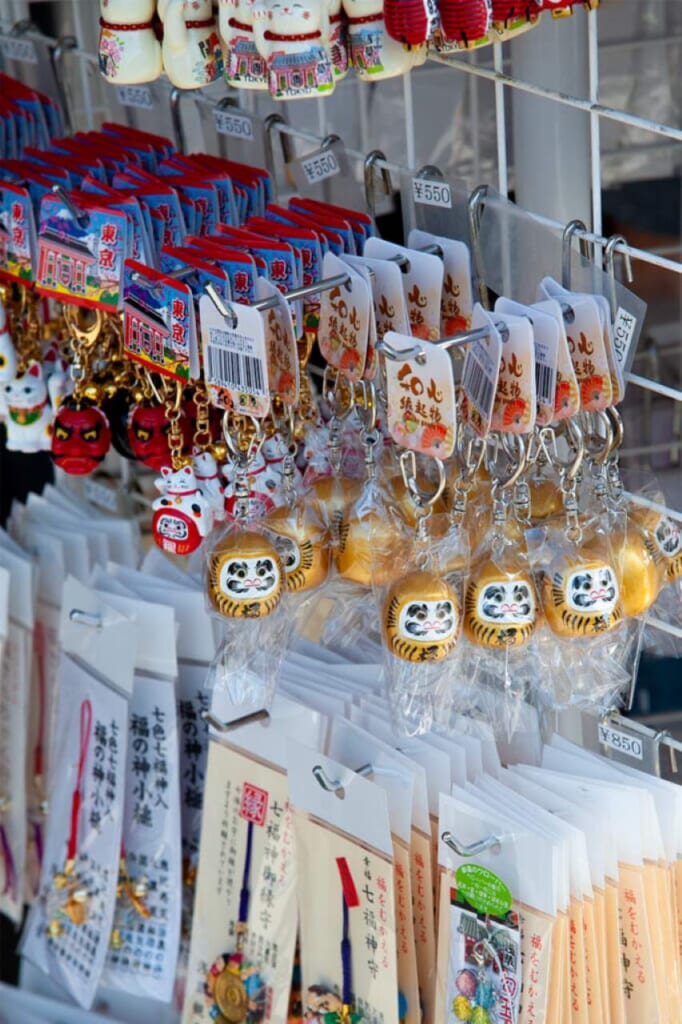
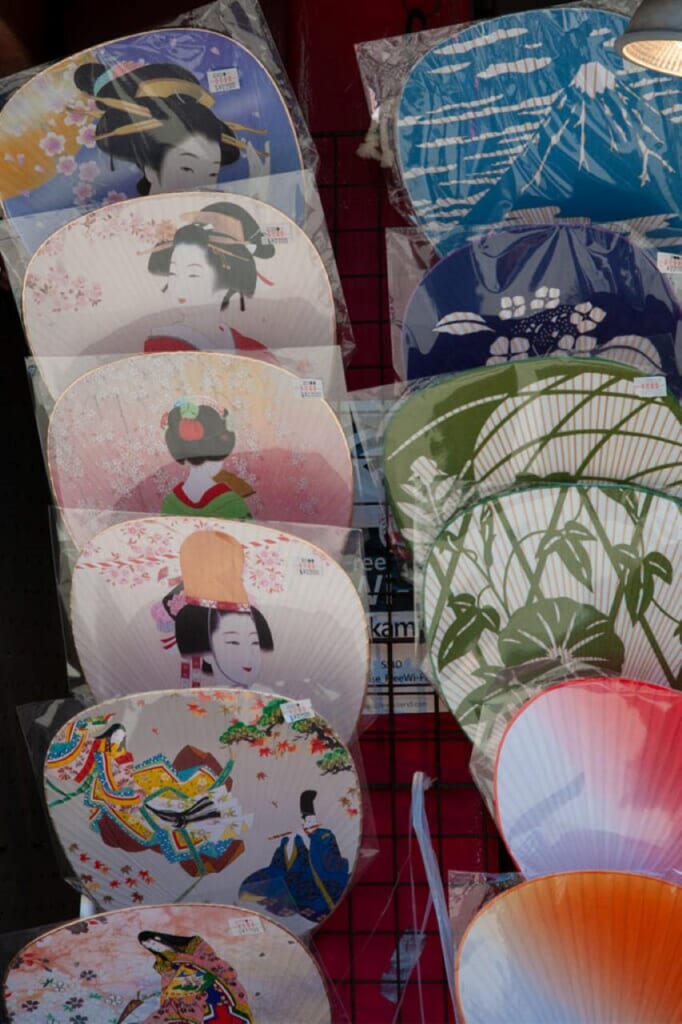
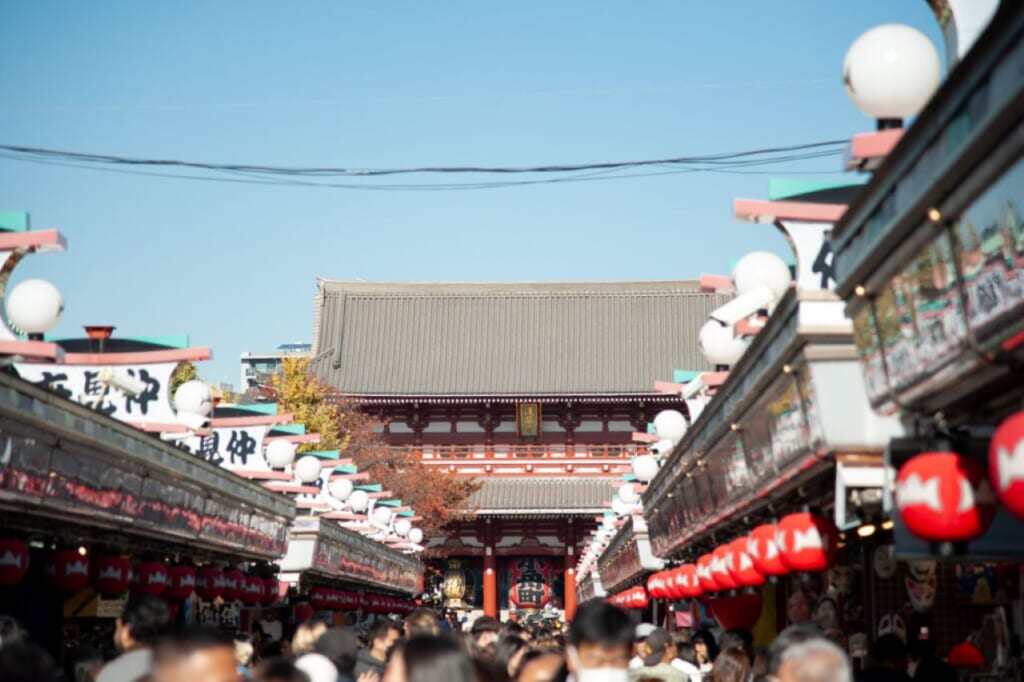
Nakamise-dori has its roots in Japan’s Edo period, originally dating from the 17th century. Today, Nakamise-dori is a great place to pick up a few mementos from your trip. As I made my way along Nakamise-dori I soon noticed the enticing smell of freshly made traditional Japanese snacks. Sweet cakes filled with red bean paste called Ningyoyaki and savory crackers called senbei are two must-try local specialities.
Exploring the Heart of Sensoji Temple
Behind Nakamise-dori are the majority of the buildings that make up Sensoji Temple. Despite its long history, the majority of Sensoji’s buildings were destroyed by fire and rebuilt many times over the centuries, most recently after the Second World War.
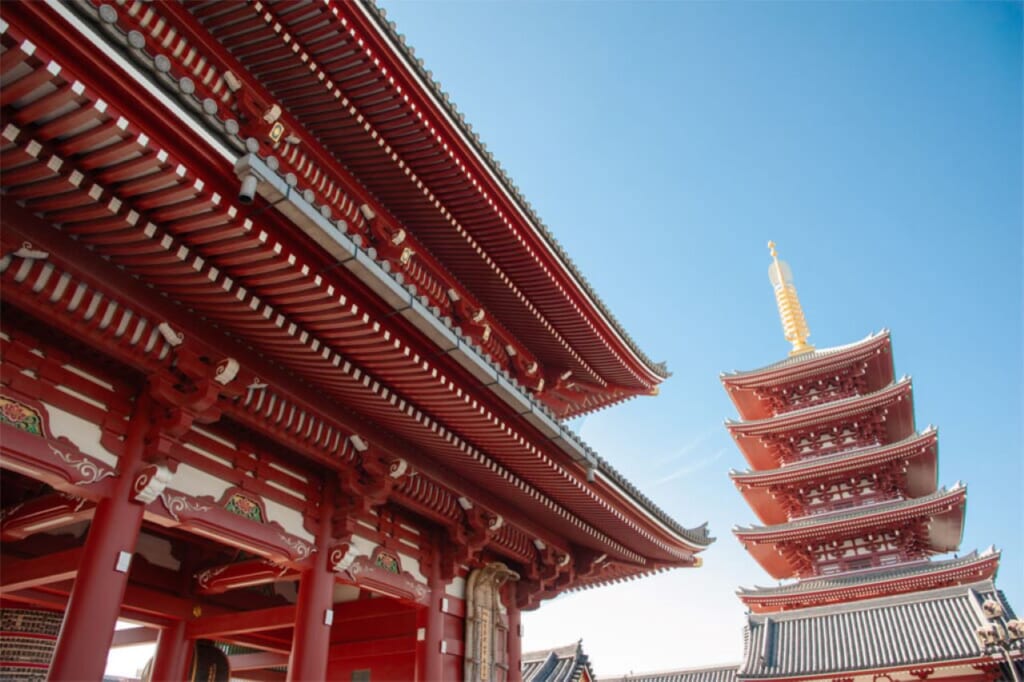
At the end of Nakamise-dori is Sensoji’s second imposing gate, Hozomon Gate, which stands next to an elegant five-storied pagoda and in front of Sensoji Temple’s giant main hall. Just like Kaminarimon Gate, Hozomon Gate also features two grand statues of the gods of thunder and wind, as well as its own enormous red lantern.
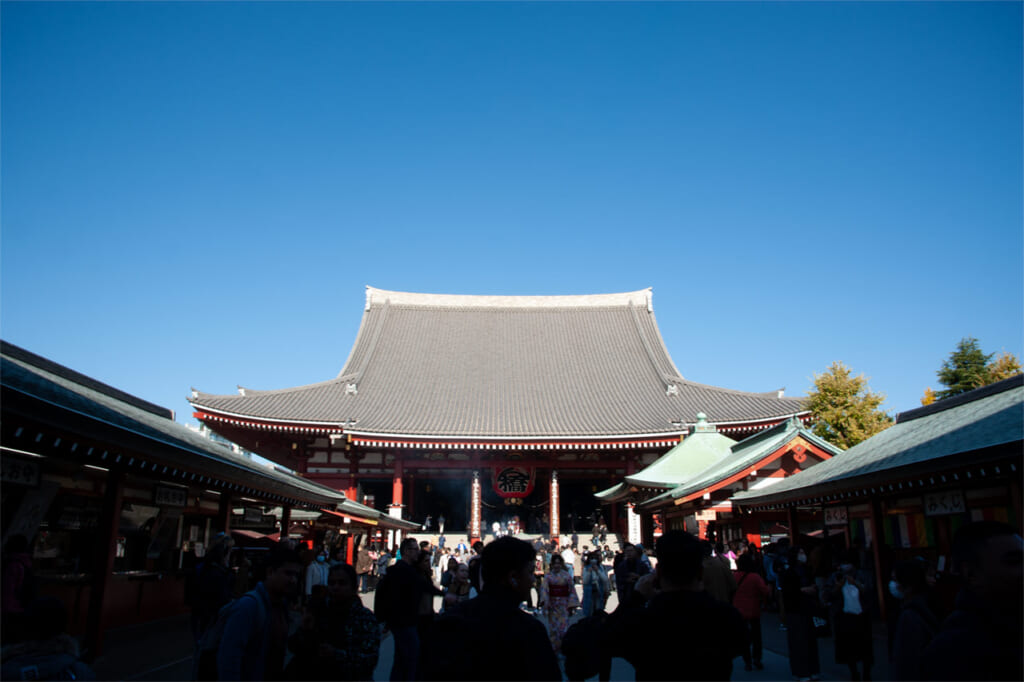
Sensoji Temple’s main hall houses a stunning statue of Kannon, the Goddess of Mercy, to which many visitors offer their prayers. Just in front of the main hall stands a large incense burner. As well as producing a wonderful aroma, according to ancient Japanese myth it was believed that waving the smoke of the burning incense towards your body could heal aches and pains. Today, it is common to see younger people try to pass the scent over their heads in order to give them the wisdom to pass exams.
A Tempura Lunch at Aoi Marushin
After such a busy morning I’d built up quite a hunger. There’s a huge selection of restaurants and izakayas to be found in the bustling network of streets around Sensoji Temple. Looking for traditional and seasonal cuisine I made my way to Aoi Marushin (葵丸進), a popular restaurant just a few minutes walk from Sensoji’s Kaminarimon Gate.
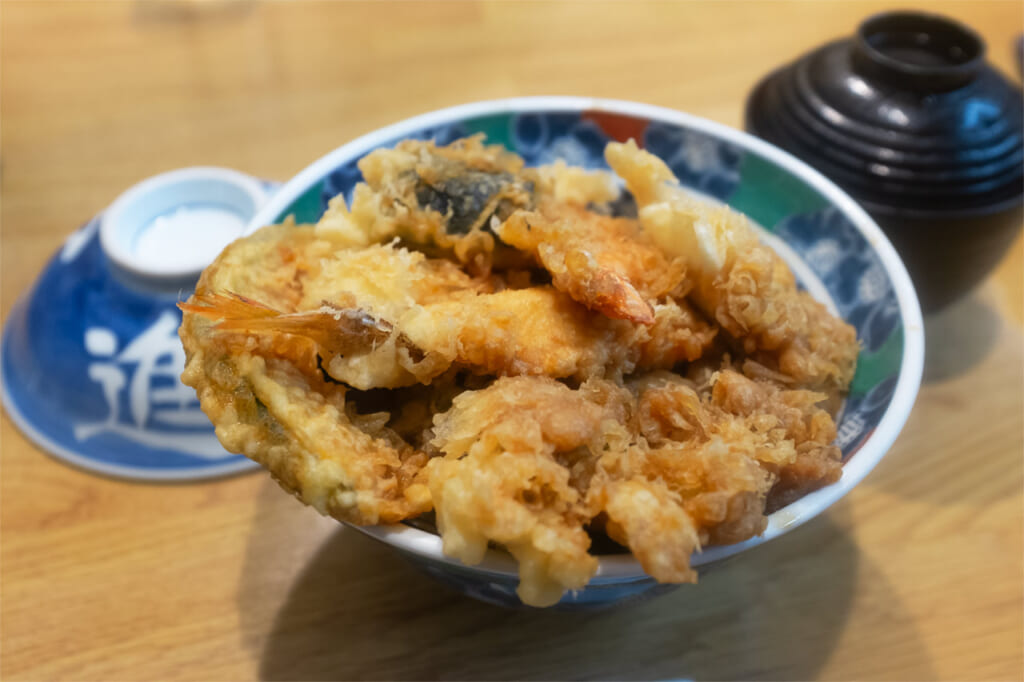
Aoi Marushin specializes in tempura, a dish consisting of fish, seafood and vegetables which are coated in a crispy batter before being deep fried. I decided to go for the house special of tendon, a delicious and very filling bowl of assorted seasoned tempura topped with sauce and served on top of a generous serving of rice.
Walking the Charming Streets of Yanaka
After lunch I made my way to Yanaka, a historic area of Tokyo that still retains an atmosphere of a bygone age. This is most evident on Yanaka Ginza (谷中銀座), the narrow shopping street that cuts through the center of the area. All along Yanaka Ginza are dozens of shops that sell all manner of traditional Japanese crafts and clothes, such as vintage kokeshi dolls and beautiful second hand kimonos.
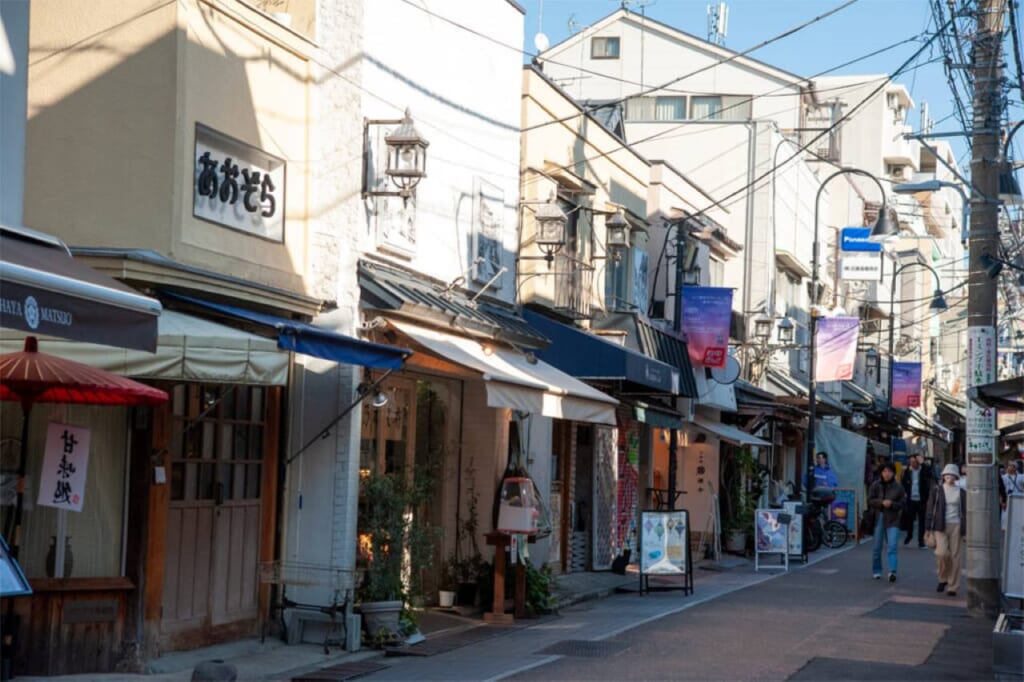
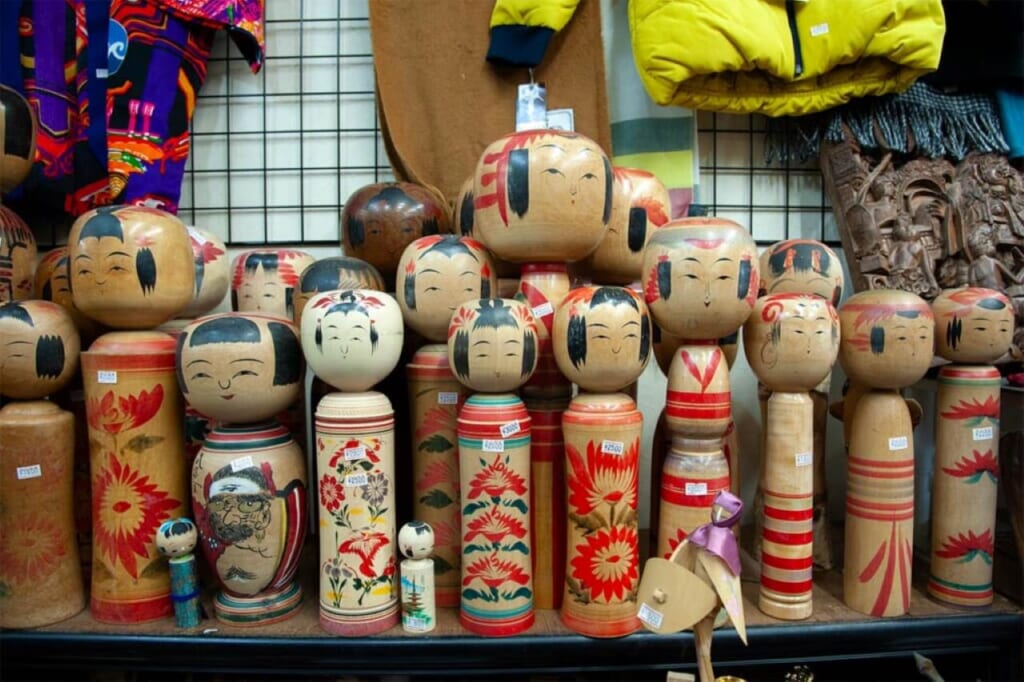
Yanaka Ginza is also a great place to feast on street food snacks. Here you’ll find long-established stores and delicatessens that offer a huge selection of typical Japanese snacks, from senbei crackers, tempura, deep-fried croquettes, and even grilled oysters.
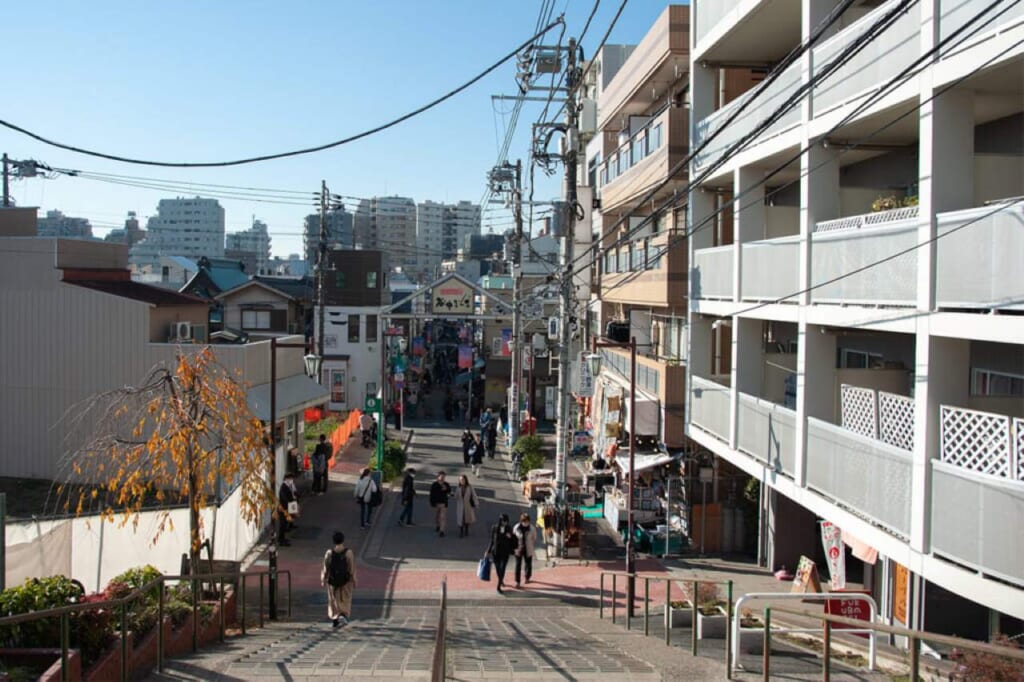
At the far end of Yanaka Ginza is the area’s most famous landmark, Yuyake Dandan (夕やけだんだん). Yuyake Dandan is a short staircase which offers wonderful views of the area, particularly in the late afternoon as the sun begins to set.
Sensational Night Views of Tokyo from SHIBUYA SKY
With the evening starting to draw in and darkness beginning to fall I made my way to Shibuya, the beating heart of Tokyo. There’s no better way to see the magnitude of the city than from an elevated viewpoint, and the SHIBUYA SKY (渋谷スカイ) observation area offers some of the finest views of Tokyo from right in the center of the city.
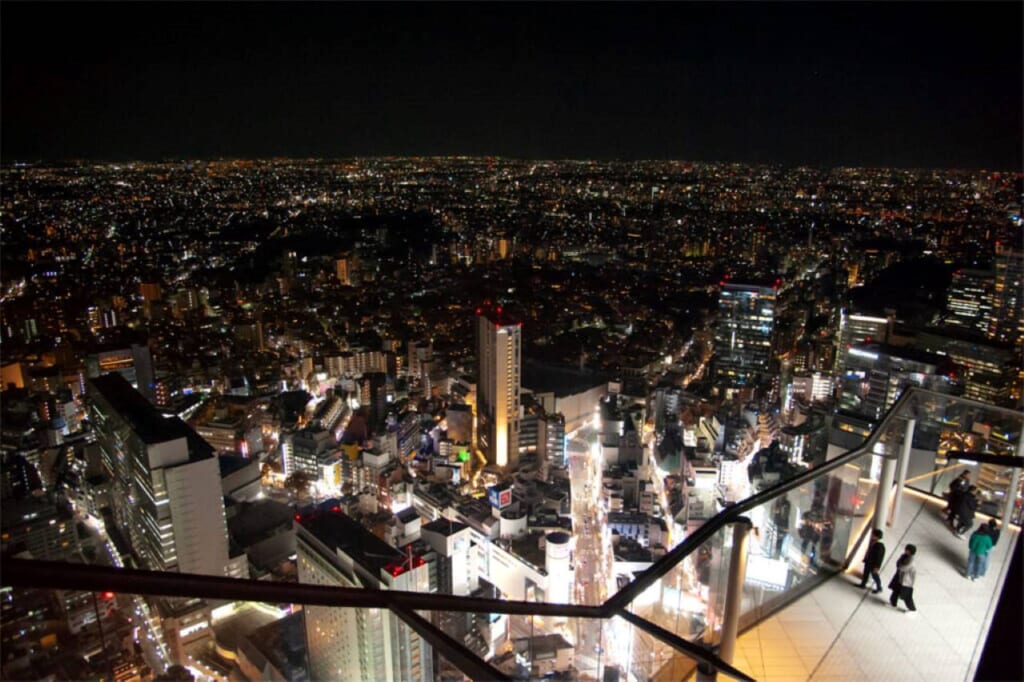
SHIBUYA SKY’s observation area sits on the top floor and the roof of the SHIBUYA SCRAMBLE SQUARE (渋谷スクランブルスクエア) skyscraper. On the 46th floor is the indoor SKY GALLERY, a relaxing area to wander and admire the completely unobstructed view of the city and far beyond. On the roof is the SKY STAGE, an open air sky deck at a height of 229 meters from street level.
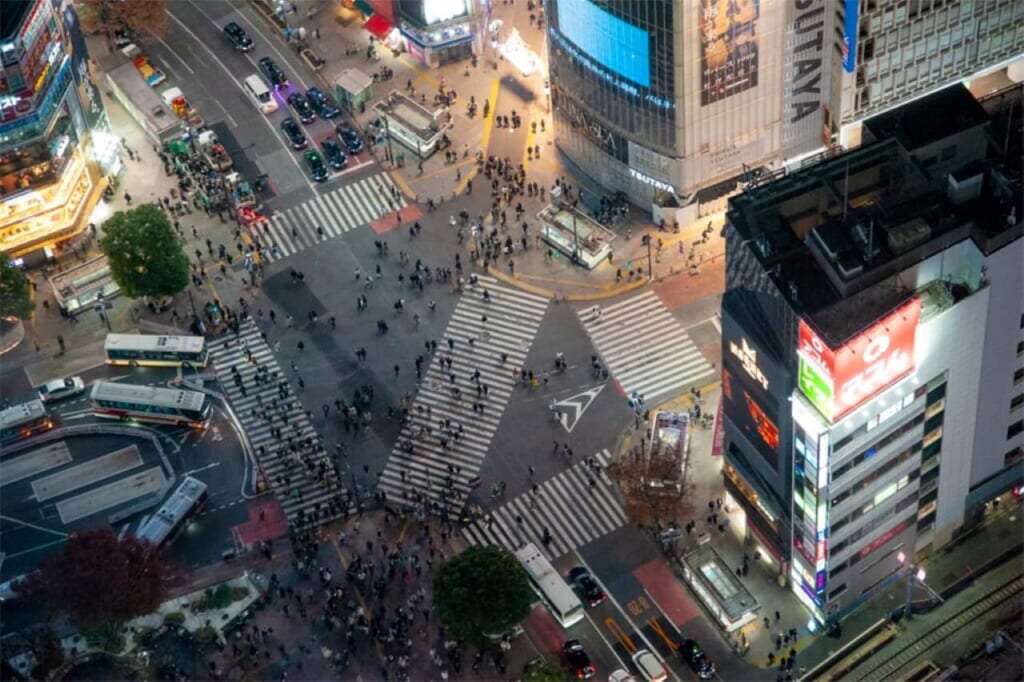
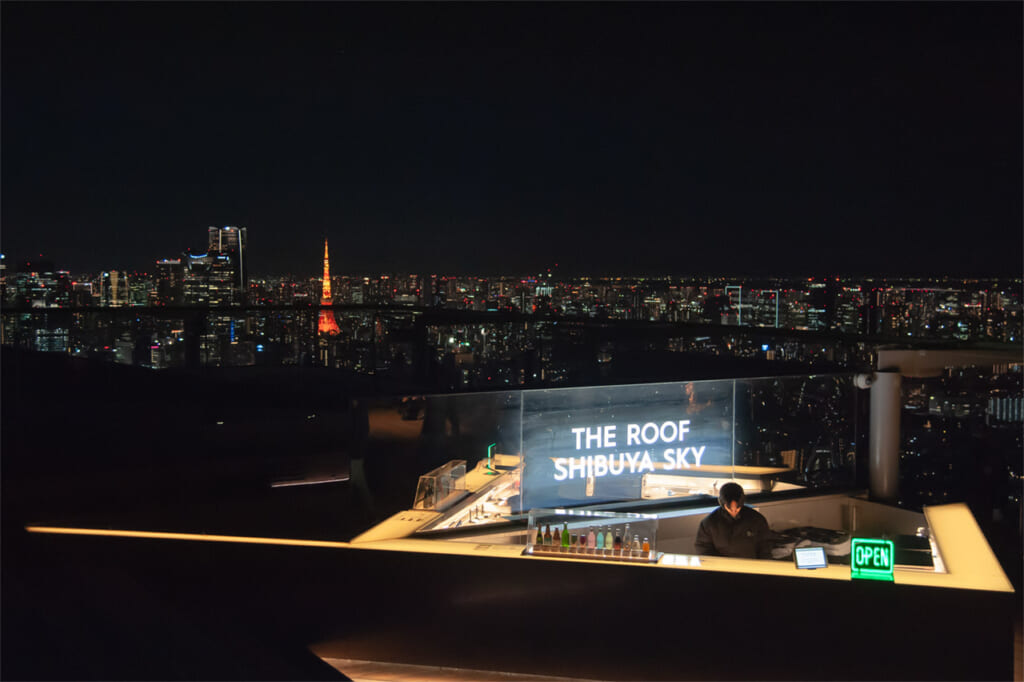
After dark, the dazzling lights of the Tokyo skyline stretch out as far as the eye can see. Among the panoramic city views are illuminated landmarks, such as the Tokyo Skytree and the Tokyo Tower, as well as a birdseye view of the famous Shibuya Scramble crossing.
Check in at the La Vista Tokyo Bay
That night I checked into the La Vista Tokyo Bay Hotel, perfectly located for exploring the first stops of the next day’s itinerary. The hotel is renowned for its choice of hot springs, where you can relax in the soothing mineral baths whilst enjoying wonderful views of Tokyo Bay.
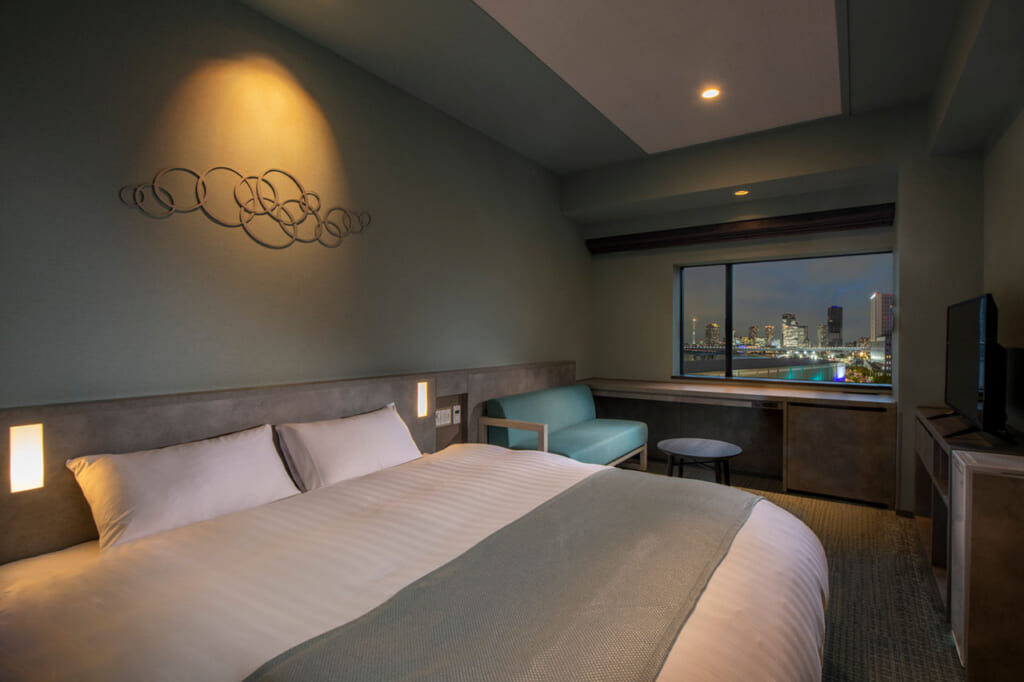
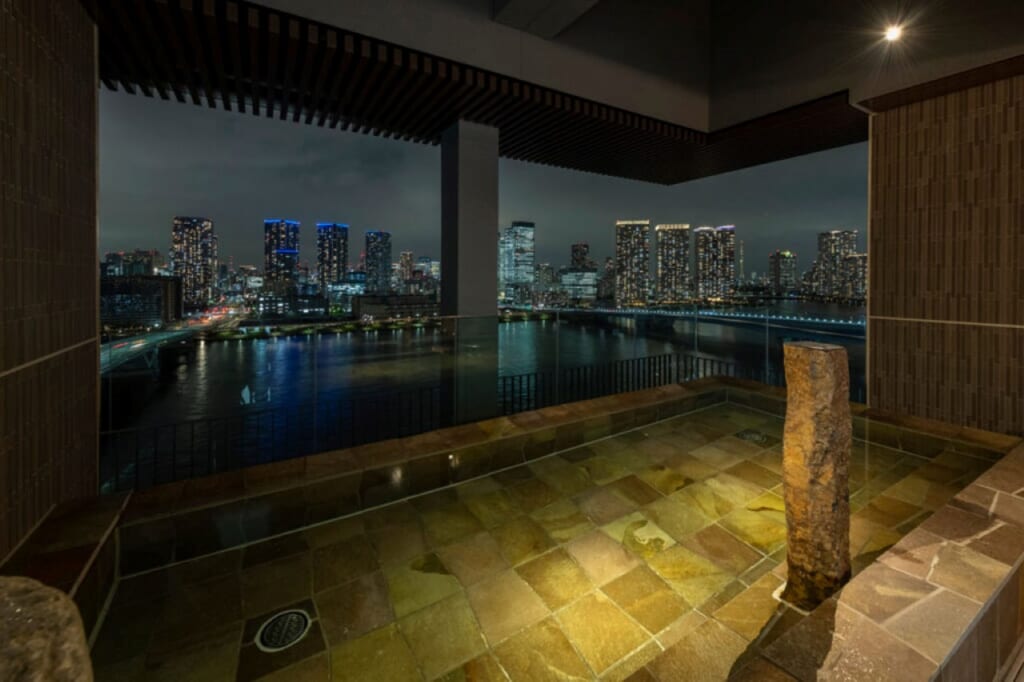
The La Vista Tokyo Bay’s spacious and contemporary rooms have wonderful views of the Rainbow Bridge, another of Tokyo’s most famous landmarks. If you’re hungry there are also plenty of dining options. The in-house restaurant serves multi course meals of high quality Western cuisine, while Tokinoniwa specializes in Japanese dishes with ingredients sourced from the nearby Toyosu fish market.
Day Two in Tokyo – An Early Start at Toyosu Market
Early the next morning I took the short walk from the hotel to Toyosu Market (豊洲市場). Toyosu Market is a wholesale market that was built to replace the aging Tsukiji Inner Market in 2018. The market supplies restaurants, fishmongers and grocers all over Tokyo and Japan with fresh seafood, vegetables and fruit.
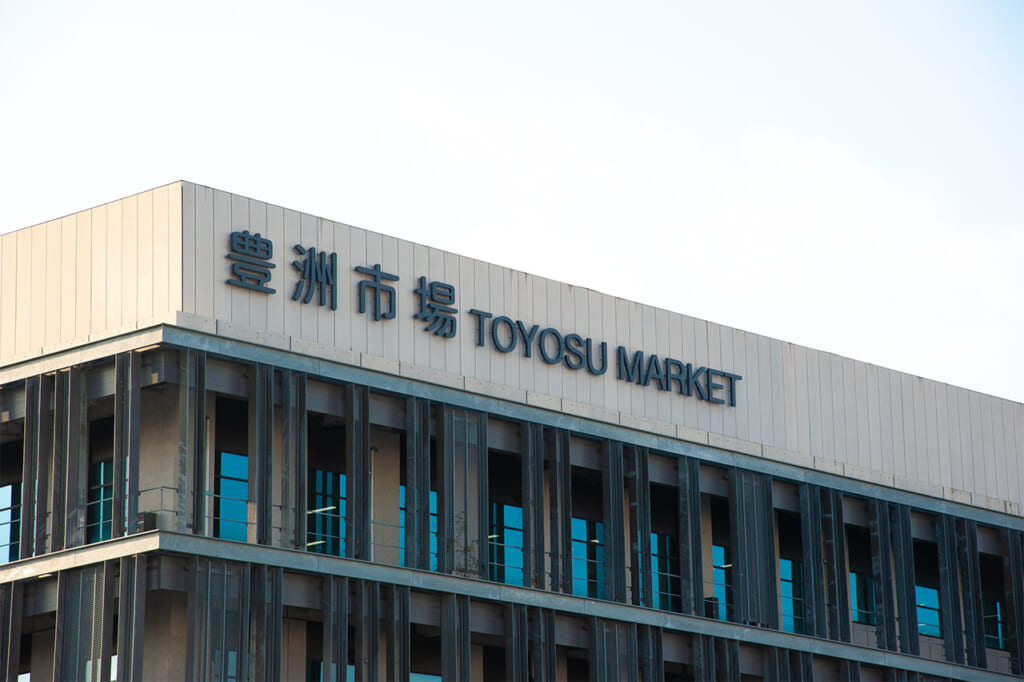
This purpose-built facility is made up of three buildings. Two buildings are dedicated to wholesalers that specialize in fish and seafood, while the third is made up of vendors selling fruit and vegetables. The new market buildings allow visitors to see the famous tuna auctions, as well as the hubbub of market activity from dedicated viewing platforms.
A Classic Breakfast at Senriken
I arrived at Toyosu Market early in the morning, though sadly not early enough to see the famous tuna auctions that begin at 5.30am. In need of a spot of breakfast and caffeine before taking a look at the rest of the market, I stopped in at Senriken, a cozy cafe on the the 3rd floor of the market’s Fisheries Intermediate Wholesale Market Building.
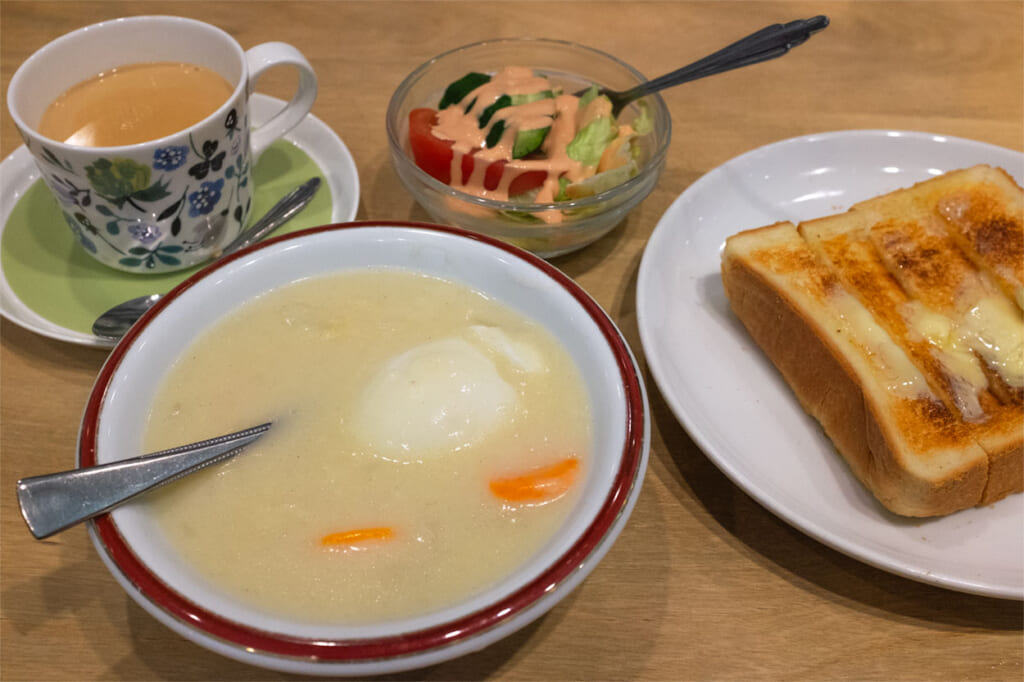
Senriken’s modern interior belies its long history. The cafe is owned and operated by the grandson of its founder, who first opened a cafe near Tokyo’s first fish market in Nihombashi in 1914. After the Great Kanto Earthquake in 1926, the fish market – and the cafe – moved to Tsukiji near Tokyo Bay. In 2018, Senriken, along with most of the restaurants formerly based in Tsukiji, relocated to the new market in Toyosu.
Having opened at 5.00am, Senriken’s friendly staff catered to a clientele of well-known regulars and visiting tourists. Senriken’s special breakfast set of buttered toast, cream stew served with a soft boiled egg, a side salad and milk tea was the perfect start to the day.
Taking a Peek into Toyosu’s Fish Market
After breakfast I visited the viewing platforms to take a look at the wide range of fish and seafood the market traders had for sale.
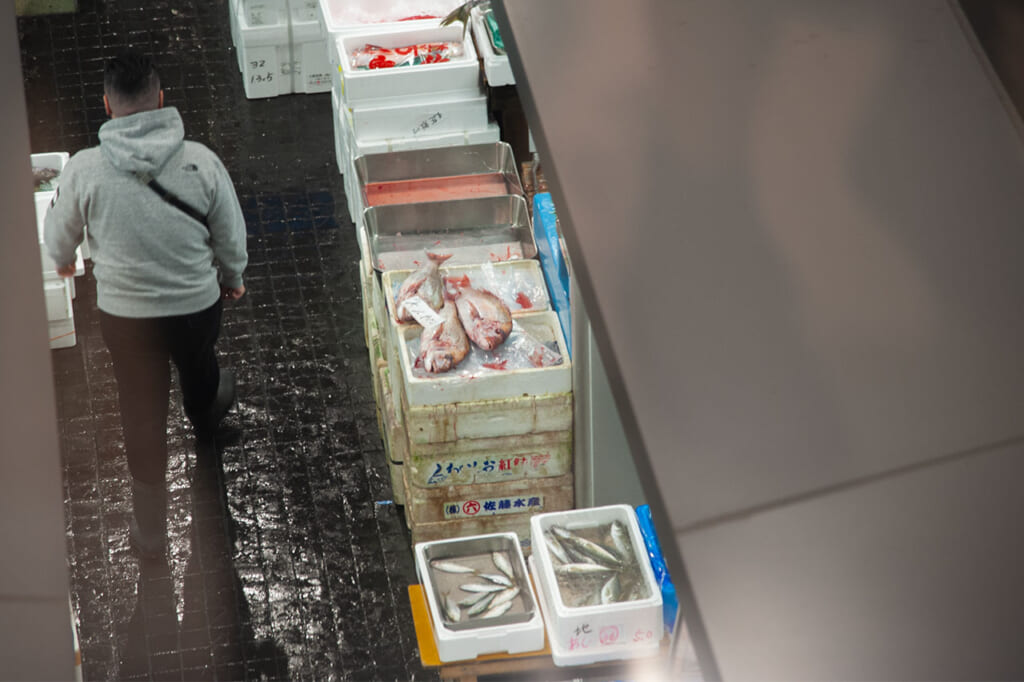
Visitors are able to watch the action and see the huge array of fresh seafood and fish that’s available from dedicated viewing windows from the floor above the market floor.
A Taste of Toyosu at Daiwa Sushi
The best place to sample Toyosu Market’s incredible seafood is by visiting one of the many restaurants that are located within the market. There’s a huge range of dining options at Toyosu Market, and one of the most popular is Daiwa Sushi, a small but very welcoming restaurant located inside the Toyosu’s fruit and vegetable market.
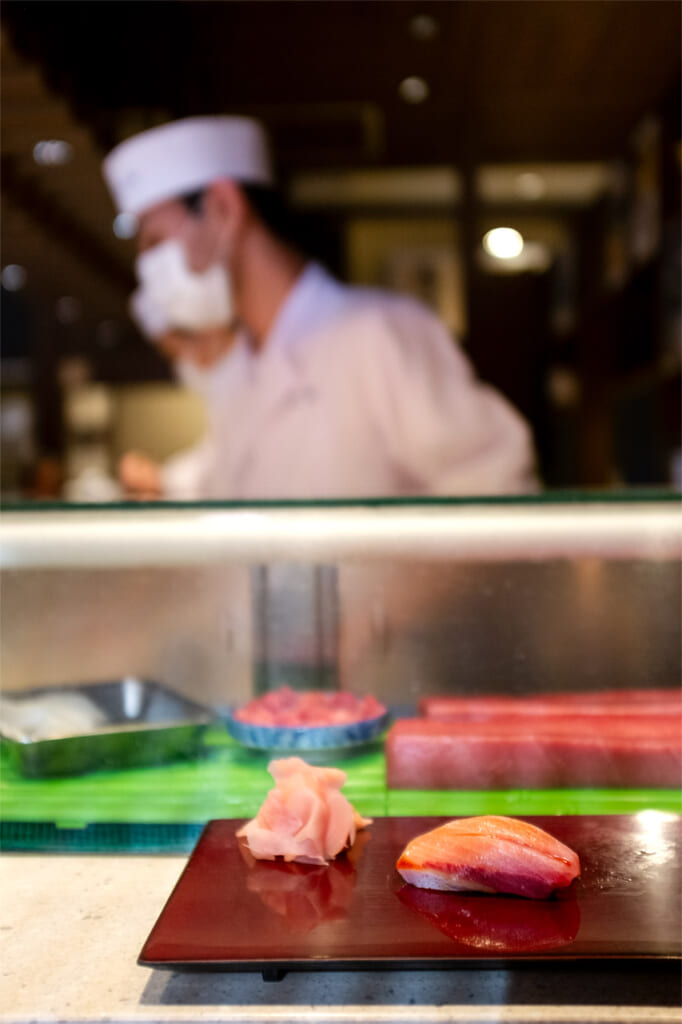
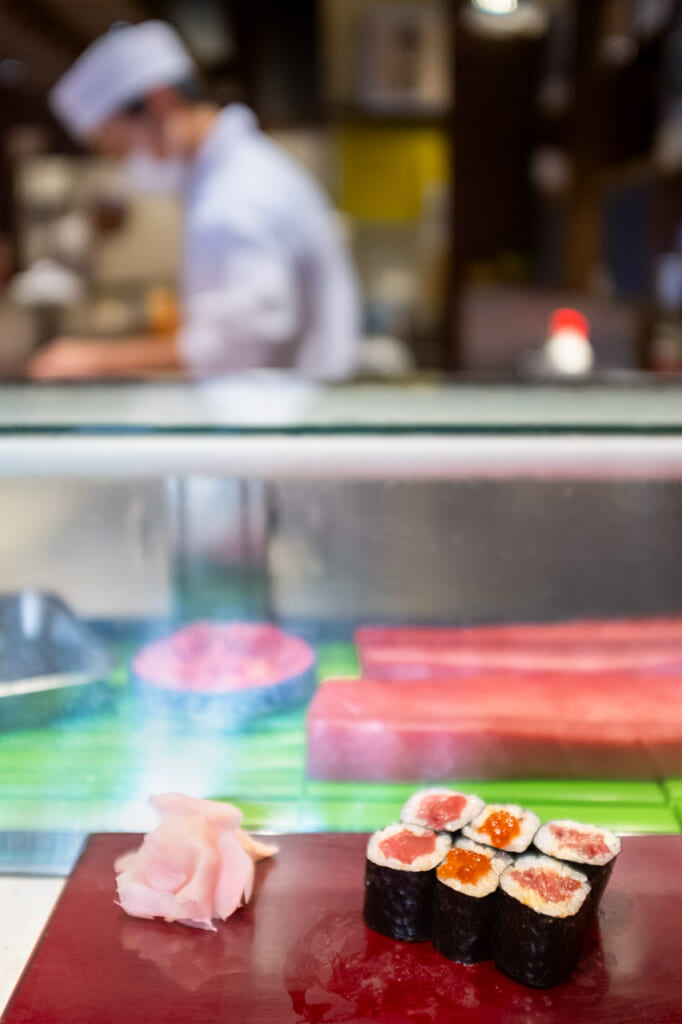
At Daiwa Sushi diners are served freshly made sushi by the chef whilst seated at the counter. I’m always able to find room for sushi so I opted for the omakase course – seven delicious servings of freshly prepared nigiri sushi and maki rolls of the chef’s choice.
The sushi is made from the freshest fish and seafood, which is sourced every single morning from Toyosu Market. Each serving of the omakase course is a feast for the eyes as well as the taste buds, and included plates of sumptuous sushi made of tuna, squid, sea urchin, shrimp, sea bream and ocean eel.
Sensory Overload at teamLab Planets TOKYO
Following lunch I was excited to visit teamLab Planets TOKYO, just a ten minute walk from Toyosu Market. One of the most popular attractions in Tokyo, teamLab Planets is a fully immersive modern art exhibition that uses light, color, water, art projections and more in a number of incredibly playful and inventive ways to overwhelm the senses.
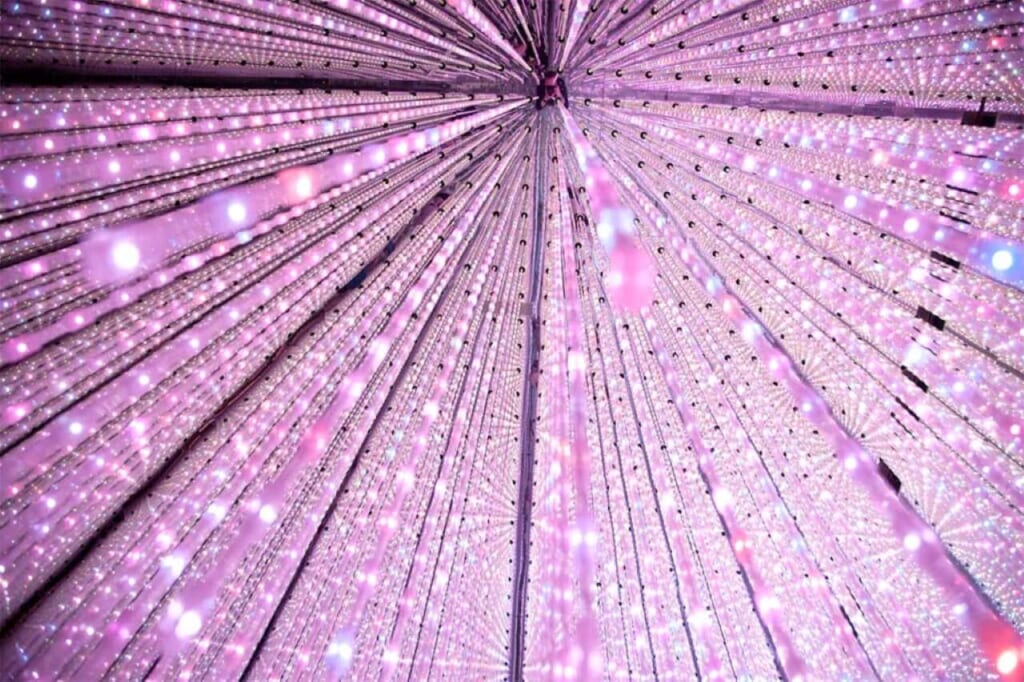
Each room in the teamLab Planets TOKYO exhibition features a different and totally unique experience that needs to be seen to be believed. The Infinite Crystal Universe features thousands of tiny glittering LED lights that hang from the ceiling reflecting off mirrored walls and floors. The Floating Flower Garden features about 14,000 live orchids floating in the air.
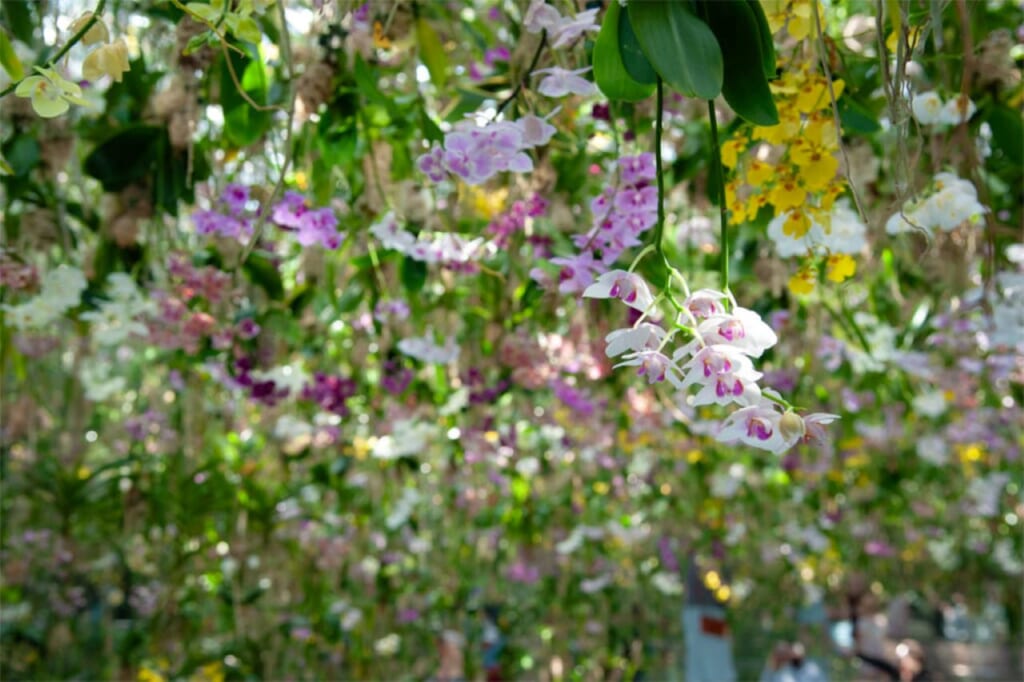
The immersive aspect of teamLab Planets is taken to another level in the exhibition’s water art, where colorful koi carp and flowers are projected onto a pool of knee-deep water. A total sensory overload, teamLab Planets TOKYO is an unforgettable experience.
Visiting TOKYO NODE at Tokyo’s Latest Landmark Tower
From teamLab Planets TOKYO I traveled into Tokyo’s global business district of Toranomon to visit the area’s newest landmark tower. Toranomon Hills Station Tower is a 49 floor skyscraper that opened in October 2023. The tower has direct access to Toranomon Hills metro station, and includes plenty of retail and dining options on the lower basement floors. The tower is also home to TOKYO NODE, a mix of gallery spaces, event halls, restaurants and a rooftop pool.
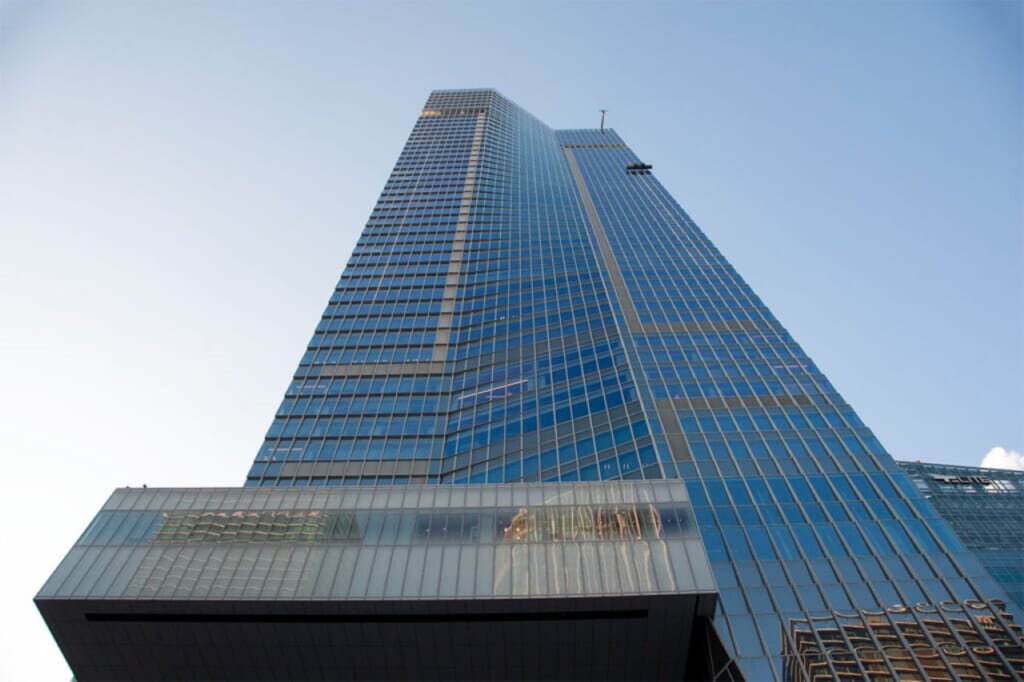
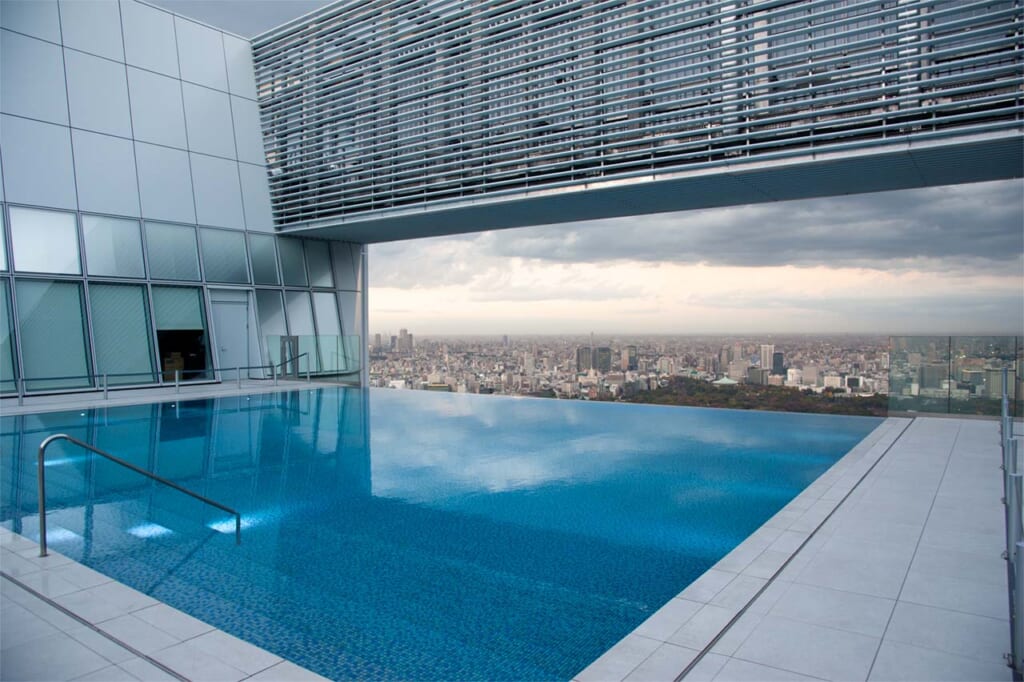
The entrance to TOKYO NODE is on the tower’s eighth floor. Here, alongside a chic yet relaxed cafe, is the TOKYO NODE LAB, a shared creative and state of the art volumetric video studio where companies can collaborate on a variety of projects. On the 45th floor is TOKYO NODE’s arrival hall and three gallery spaces, which host a series of ambitious exhibitions throughout the year. On the very top floor are two restaurants, apothéose and KEI Collection PARIS, both of which are run by Michelin-starred chefs. Both restaurants also open out onto the tower’s Sky Garden and outdoor infinity pool. At 250 meters above ground level, this is the highest rooftop pool in Japan.
A Kaiseki Feast at Miyuki
In the evening I enjoyed a wonderful Japanese kaiseki meal at Miyuki, just one of the restaurants at the Hotel Chinzanso Tokyo. Traditional kaiseki cuisine consists of multiple courses of beautifully prepared and presented small plates of food. This style of dining began in Japan several centuries ago, with the emphasis on its presentation, elevating the experience to an art form as much as a meal.
Each course of kaiseki cuisine is cooked in a different way. At Miyuki, delicious plates of grilled yellowtail fish, simmered taro and sea urchin and deep fried shrimp and vegetables are served alongside sashimi, soup and rice.
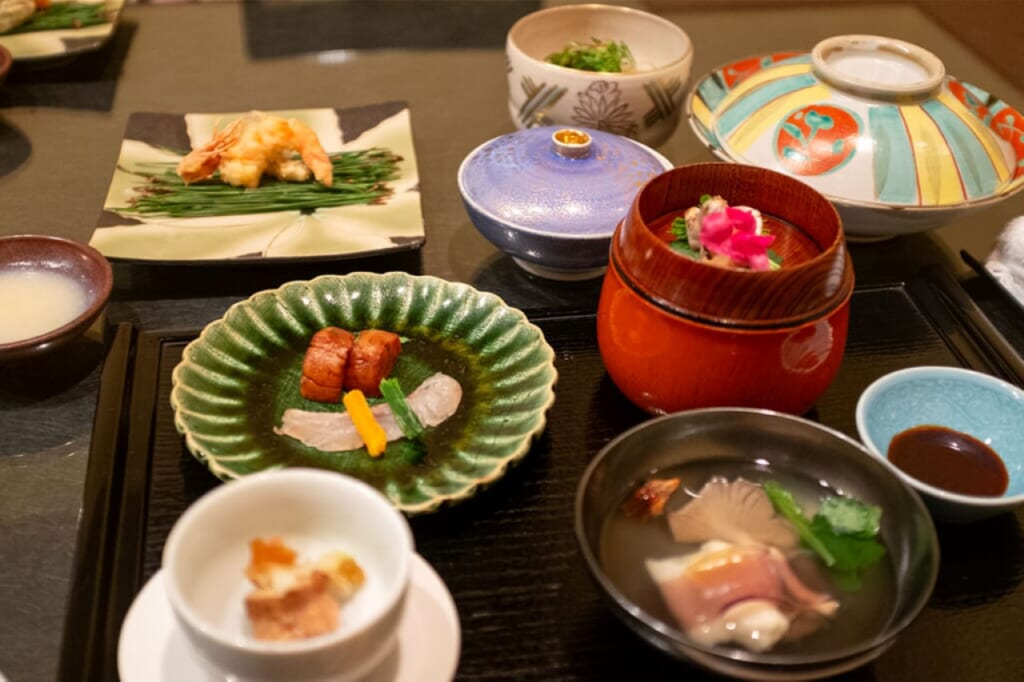
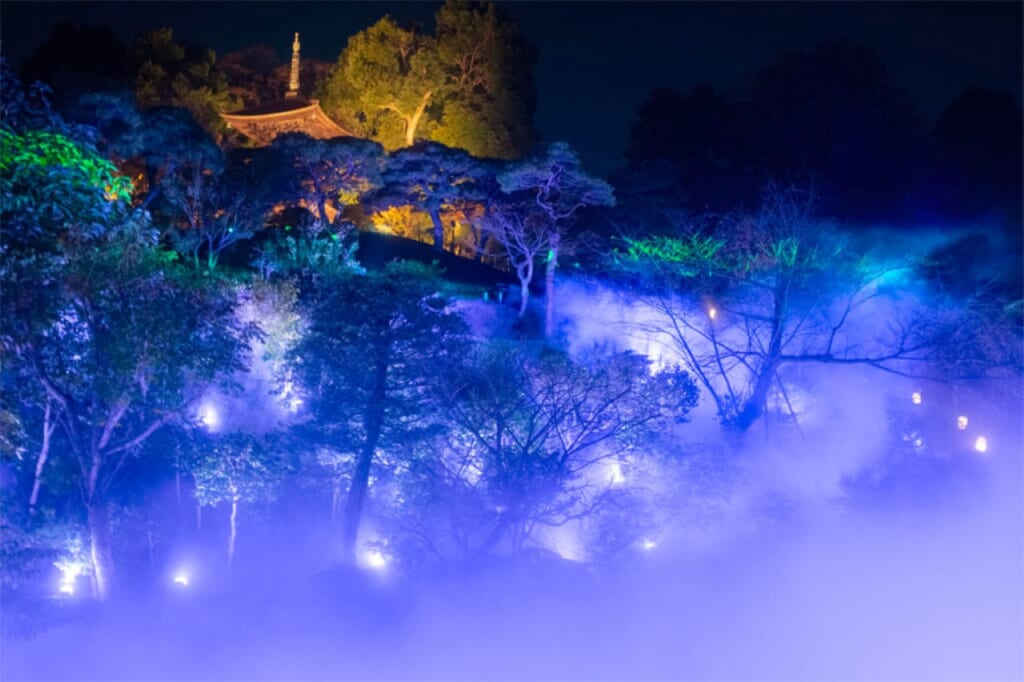
After the meal I took a stroll through the Hotel Chinzanso Tokyo’s spectacular gardens. A popular venue for weddings and banquets, at night the hotel’s garden hosts a stunning forest aurora light show and Tokyo sea of clouds performance(※until 7th of February) that augments the traditional Japanese garden, complete with its own three-story pagoda. Only hotel guests and those with restaurant reservations can access the garden.
Day 3 – An Easy Flight from Tokyo to Okinawa
The next morning I took a 3 hour flight from Tokyo’s Haneda Airport to Naha, the capital city of Okinawa Prefecture. Over the course of the next few days I learnt about many of Okinawa’s ancient traditions and the legacy of the region’s Ryukyu Dynasty.
In the Seat of Ryukyu Kings at Shikinaen Royal Garden
My first stop in Okinawa is Shikinaen Royal Garden (識名園), one of nine sites across Okinawa that were collectively awarded World Heritage status by UNESCO in 2000. The sites were granted World Heritage status due to either their cultural or natural importance.
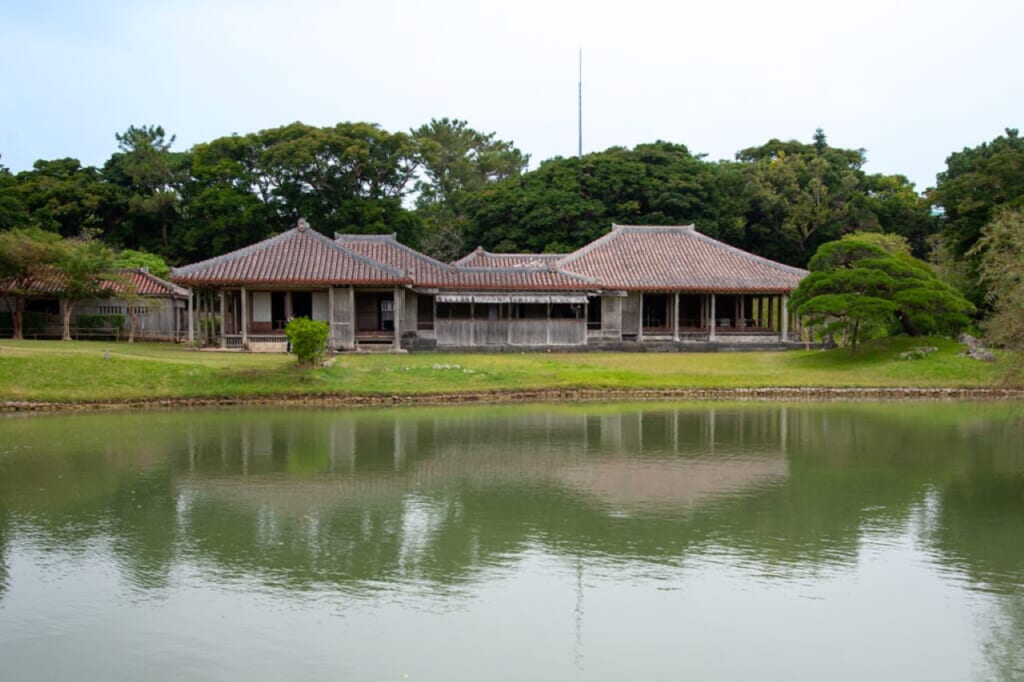
Modern-day Okinawa was once the Ryukyu Kingdom, an independent nation until the islands became a part of Japan in 1879. Shikinaen Royal Garden was built in the 18th century as a second residence for the Ryukyu kings. The house and grounds also hosted high-ranking dignitaries from China who visited the Ryukyu Kingdom in 1800. Shikinaen was completely destroyed during World War Two but the house and garden were extensively restored over a twenty year period which began in 1975.
Shikinaen’s main house and the garden features a unique blend of Ryukyu, Chinese and Japanese influences. The interior of the house, also called the Udun Palace, is laid out in a typically Japanese style. Tatami rooms are separated by shoji screens that can be removed and repositioned to change the layout of the house. The roof of the house features bright red tiles that are typical of the Ryukyu Dynasty.
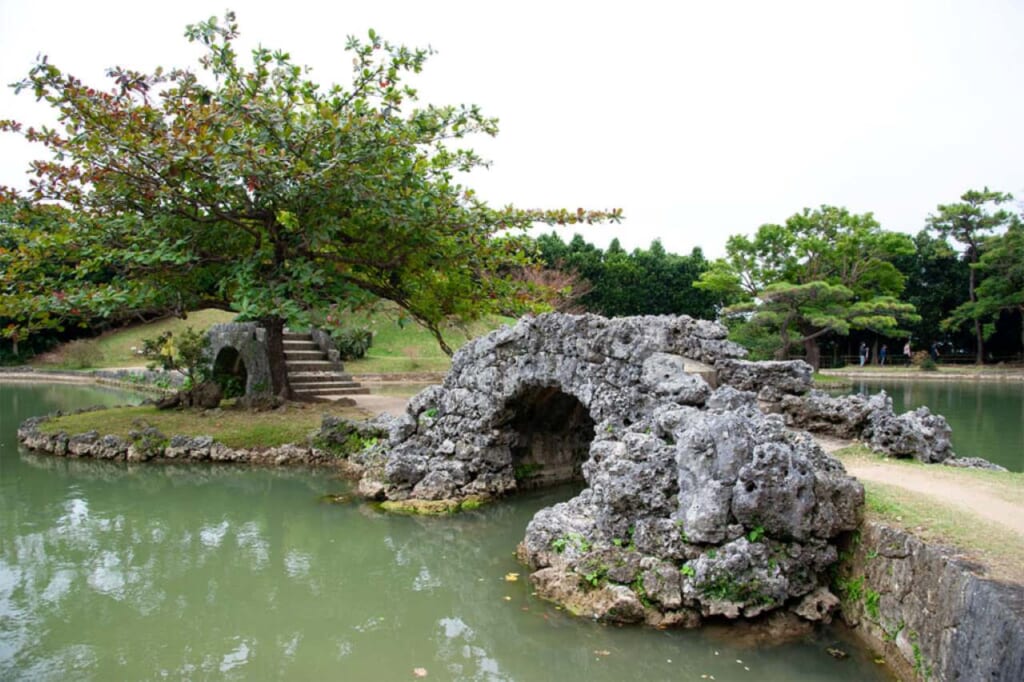
Shikinaen’s beautiful garden also boasts a large pond with two arched stone bridges and an island with a Chinese-style gazebo.
Discovering the Ryukyu Dynasty at Shurijo Castle Park
From Shikinaen Royal Garden, my next port of call was Shurijo Castle Park (首里城), another of Okinawa’s UNESCO sites. Shurijo Castle was built in the 14th century and was the political and administrative center of the Ryukyu Kingdom for over 400 years.
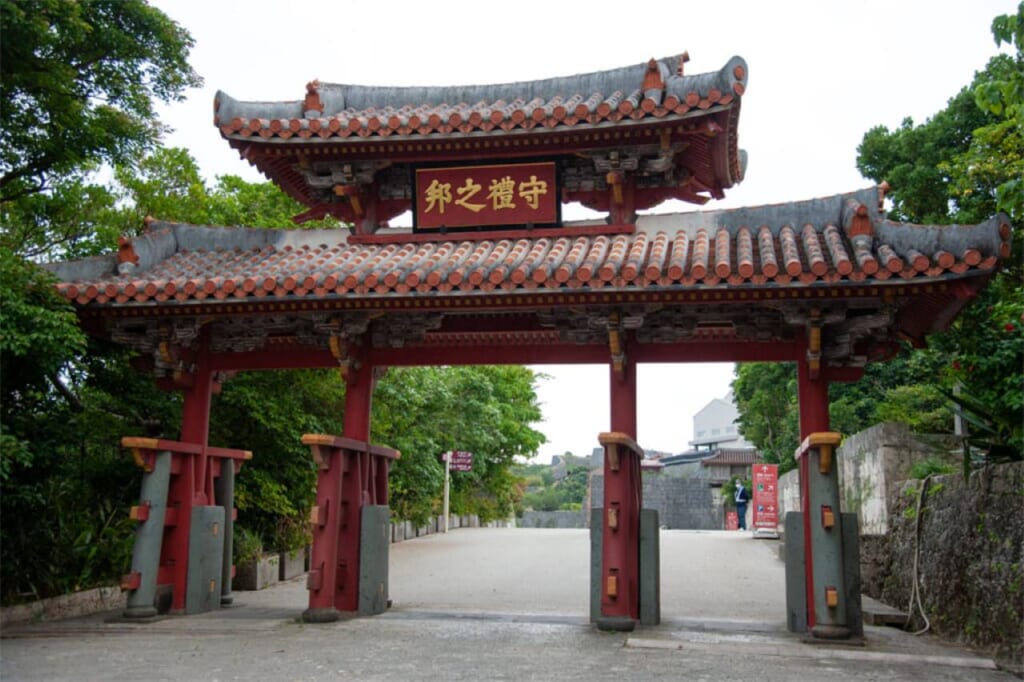
The castle’s vast grounds and most of its buildings and entrance gates display a unique blend of architecture that is typical of the Ryukyu Kingdom, just as influenced by traditional Chinese styles as much as the traditional castles found on mainland Japan. This is evident in the castle’s thick, sweeping walls and vibrant entrance gates, especially the Shureimon Gate (旧首里城守礼門), one of Okinawa’s most famous landmarks.
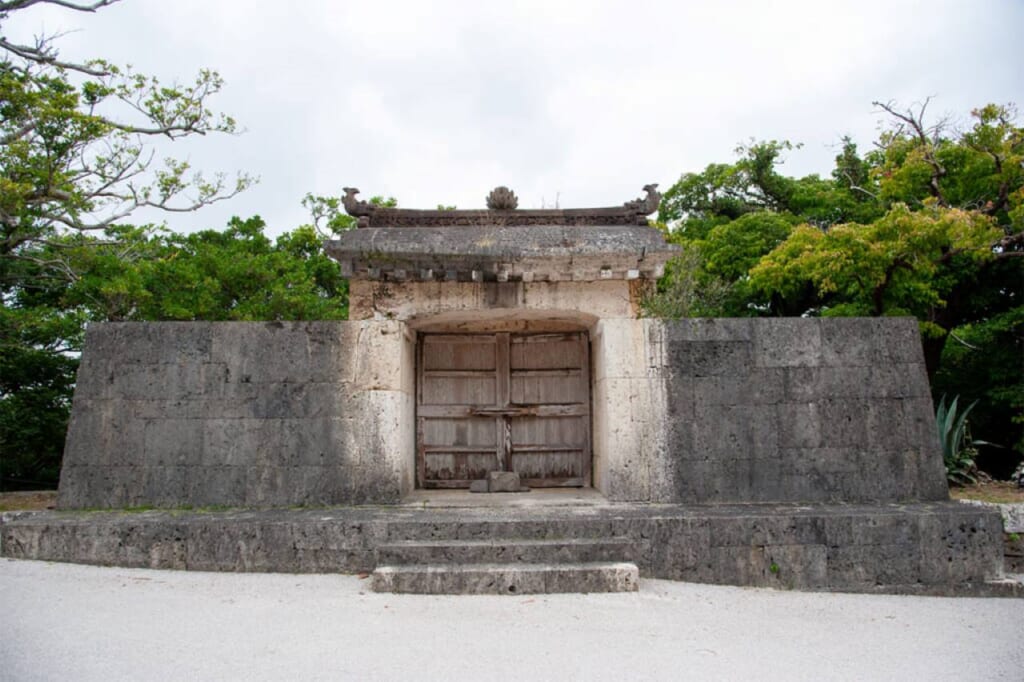
Just beyond the Shureimon Gate is Sonohyan-utaki Stone Gate (園比屋武御嶽石門), where the Ryukyu king would offer prayers before embarking on long journeys. The Sonohyan-utaki Stone Gate features intricate decorative details, such as flames and mythical creatures that are carved entirely in stone.
Shurijo Castle has seen numerous fires over the centuries and much of the site was destroyed during the Second World War. The main buildings and the grand entrance gates were later restored. In 2000 the original areas of the castle were given UNESCO World Heritage status along with eight other sites of historical importance in Okinawa.
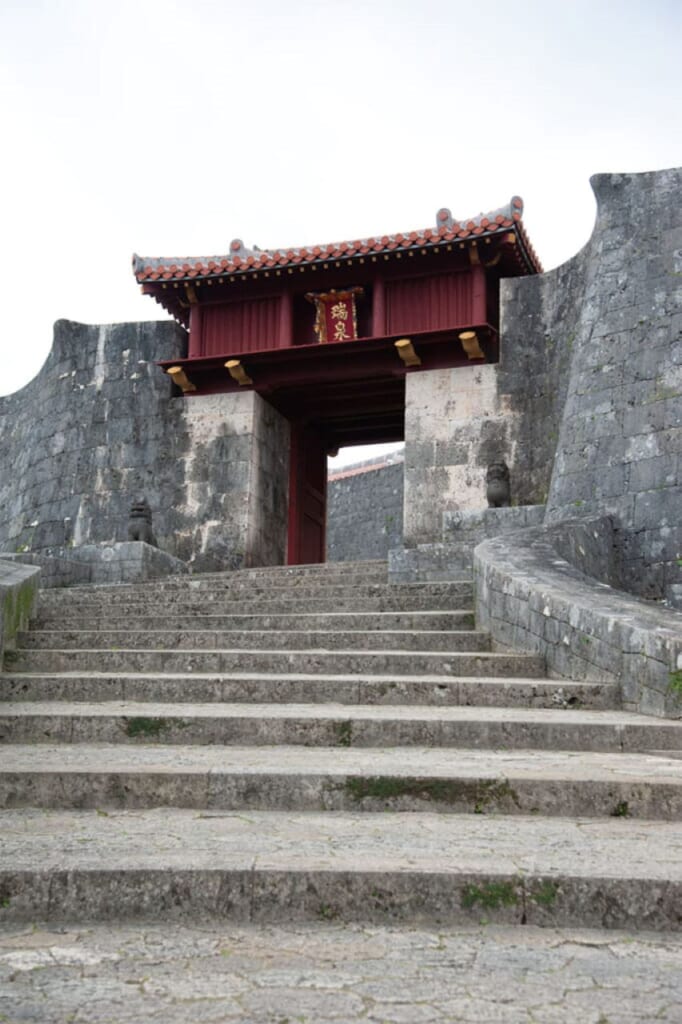
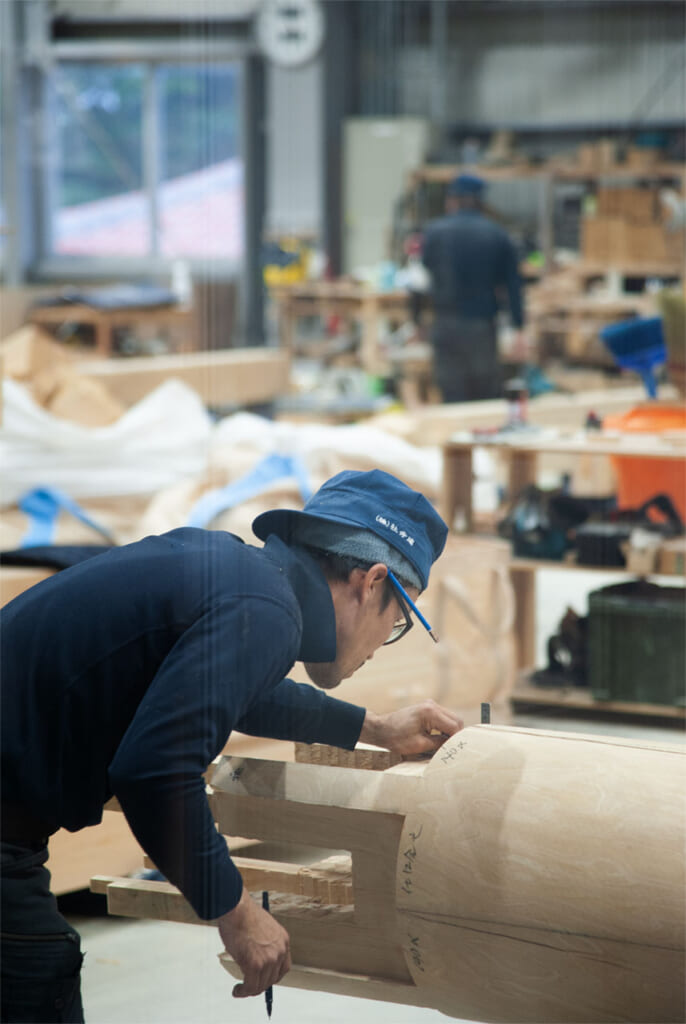
Tragically a devastating fire burned down Shurijo Castle’s beautiful main hall and several other surrounding buildings in 2019. Today, visitors can observe the intensive restoration works that are taking place to restore the castle to its former glory once again. It’s estimated that the full restoration of the castle’s keep will take another three years to complete. The efforts of the many craftsmen working to revive the castle can be seen from dedicated viewing platforms that look into the restoration site.
Okinawan Haute Cuisine at La Maison Claire 1853
That evening I had the very good fortune to visit La Maison Claire 1853. Opened in 2008, La Maison Claire 1853 prepares beautifully presented French-inspired haute cuisine made with traditional Ryukyu and Okinawan ingredients.
Kobayashi Koei, La Maison Claire 1853’s head chef, perfected his skills working in some of Japan’s finest restaurants. He also spent a number of years working in kitchens in France for several Michelin-starred chefs. The results of such a distinguished career are the extraordinary French-style dishes created from a range of delicious Okinawan ingredients at La Maison Claire 1853.
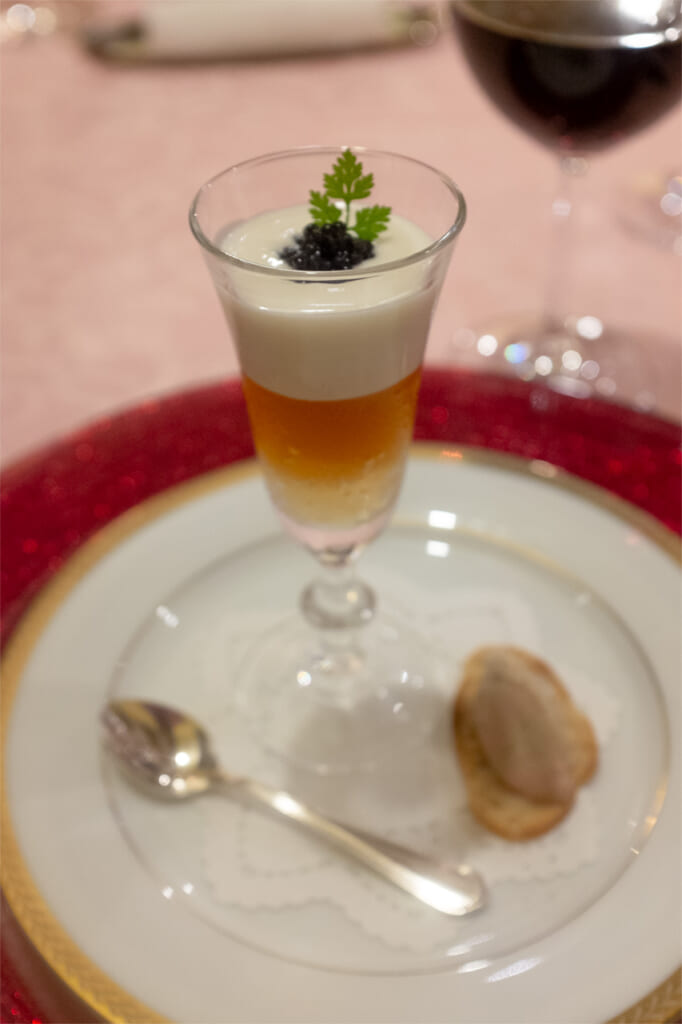
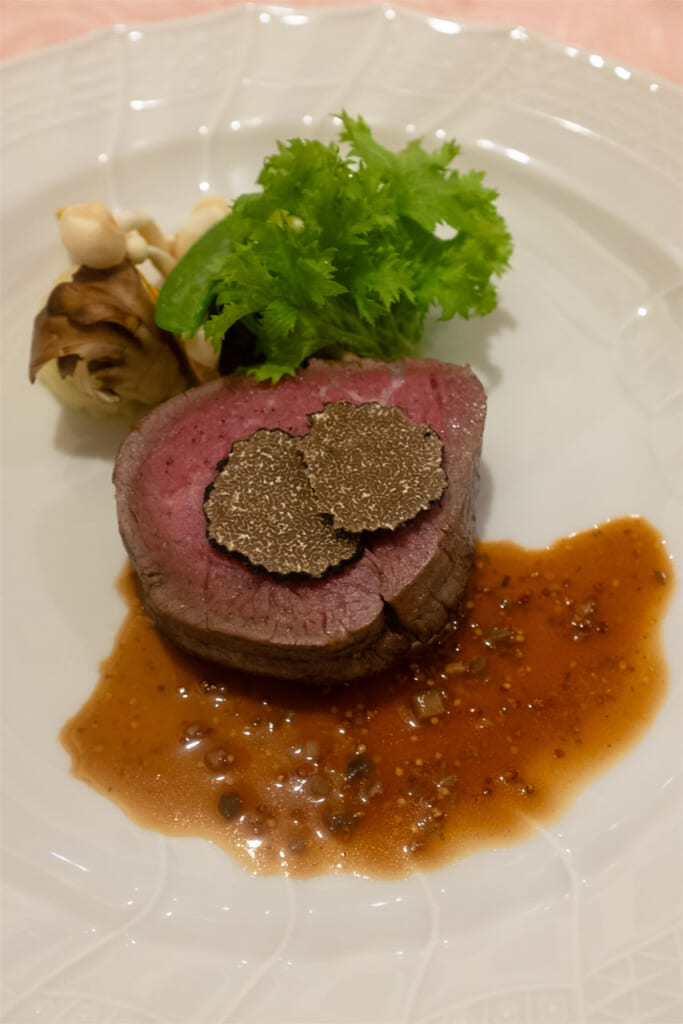
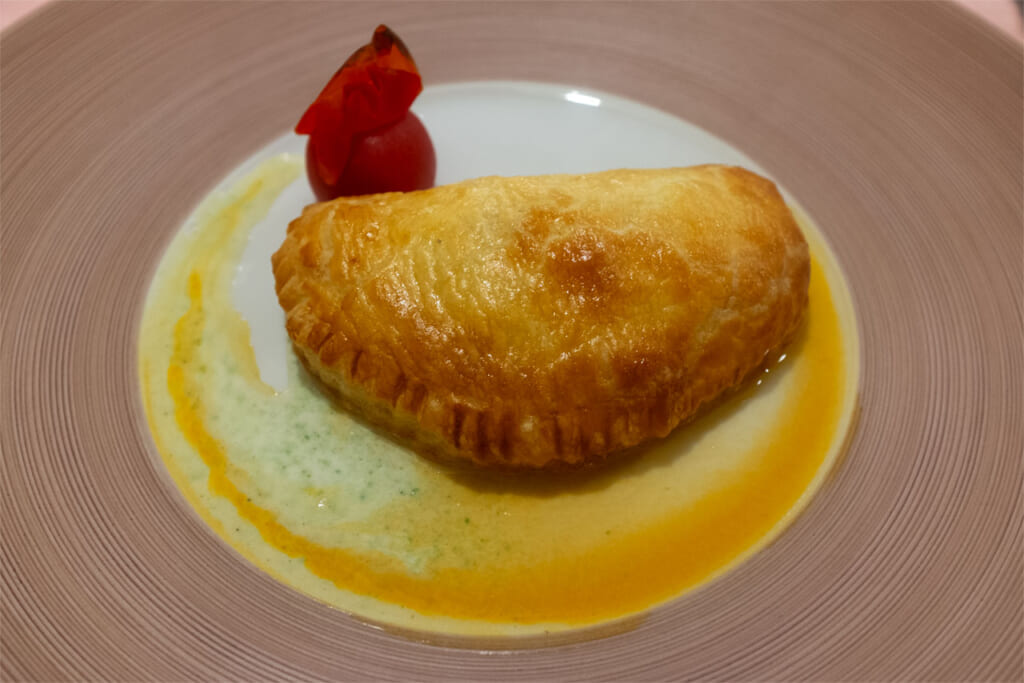
A unique and unforgettable dining experience, over the course of the evening at La Maison Claire 1853 I was treated to dish after dish of absolutely heavenly food, all of which was immaculately presented. Courses included hors d’oeuvre of locally-sourced tuna and sinewy sole, baked Ishigaki sea bream , tiger prawn in pie wrapper and a main course of Motobu beef, a type of wagyu beef from cows reared in northern Okinawa.
An Overnight Stay at the Sansui Naha Hotel
After a meal fit for a Ryukyu king I checked into my hotel for the night, the Sansui Naha Hotel. This comfortable, modern hotel boasts stylish rooms and a number of excellent amenities, including a public onsen.
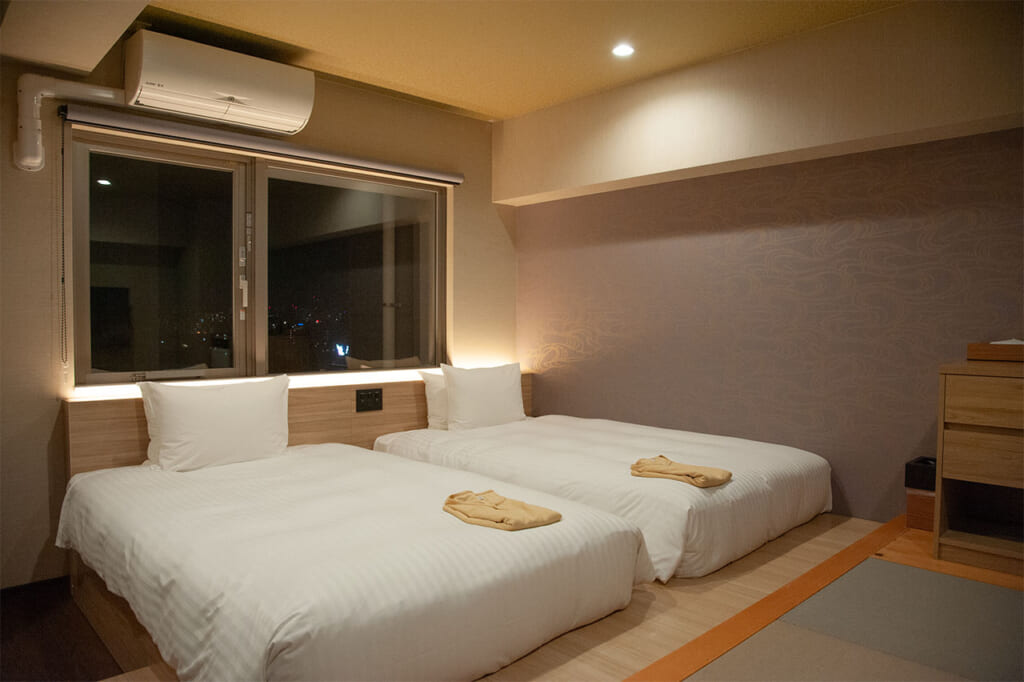
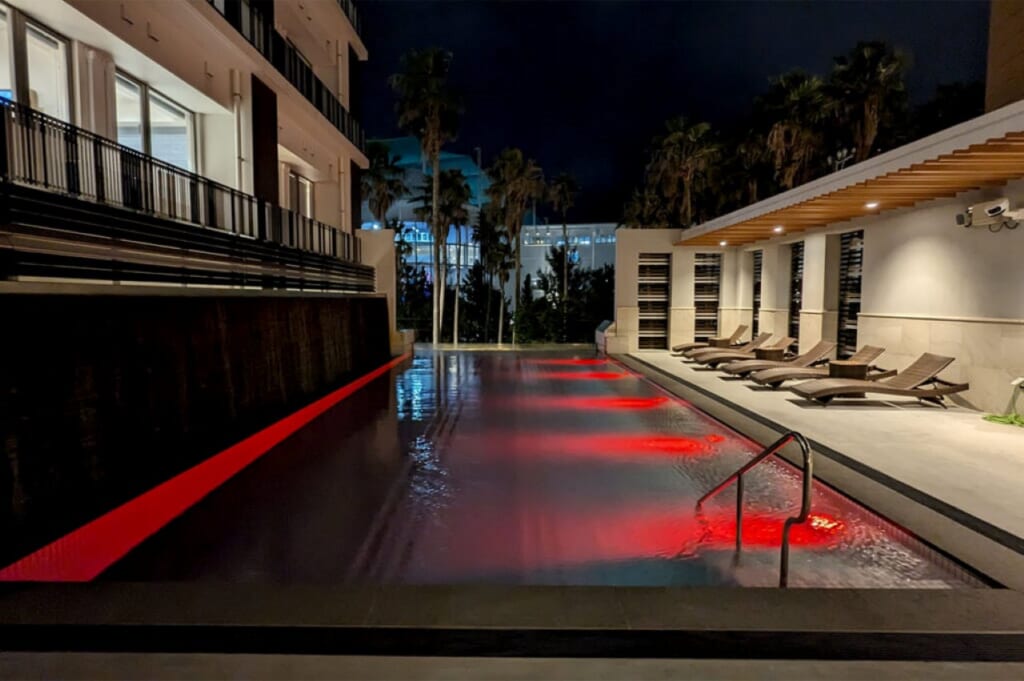
There are also two outdoor pools, one of which enjoys a wonderful view of the Naha skyline from the 14th floor. Rooms on the 11th floor and above also feature ceramic baths on a private balcony, the perfect place to relax whilst watching a beautiful sunset in the evening.
Day 4 – A Morning in Naha Before Moving North
I began the next day in Naha before gradually moving further towards the north of the island.
Enjoying A Karate Masterclass at Yagi Dojo
In the early morning I visited Yagi Dojo, a karate gym in the center of Naha. Okinawa is the birthplace of karate, where it developed during the time of the Ryukyu Kingdom. Yagi Dojo teaches a form of karate called Meibukan Goju-ryu, an ancient Okinawan style of karate that today is practiced all over the world.
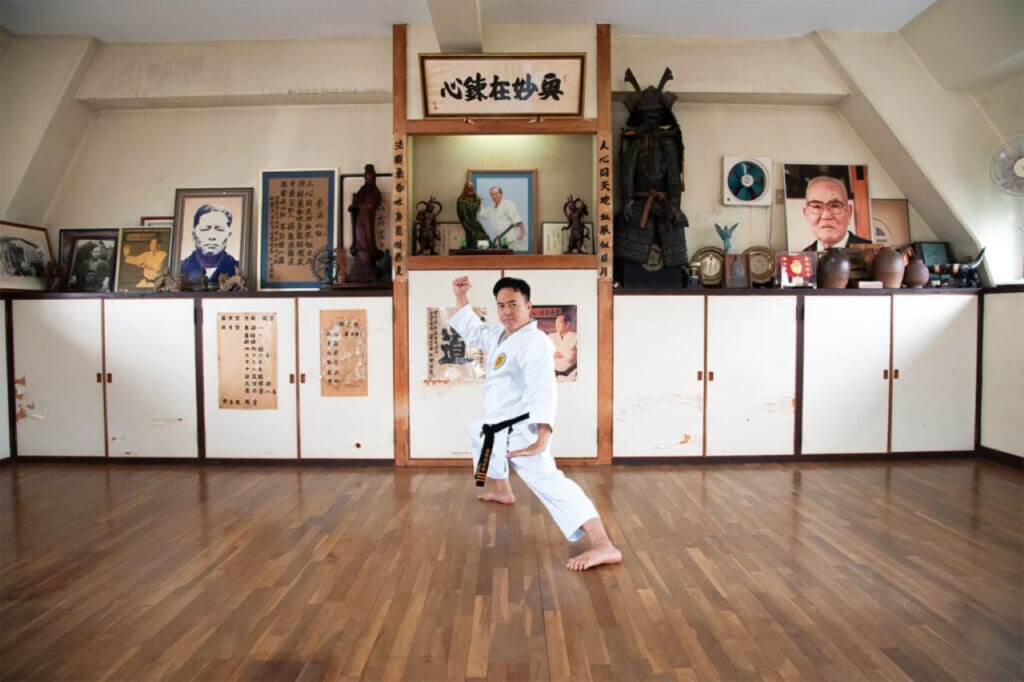
In the dojo I met my sensei for my first ever karate lesson, Yagi Akihito, who began learning the martial art at the age of 3 years old. Karate is an essential part of Okinawa culture. The martial art was invented during the time of the Ryukyu Kingdom. Karate in Okinawa developed and evolved over many centuries, always prioritizing self defence and also respect for the opponent. Three main schools of karate were established in the Ryukyu Kingdom, Shorin-ryu, Uechi-ryu and Goju-ryu. Goju-ryu is the style of Okinawan karate that is taught at Yagi Dojo. During the lesson Akihito explained that Meibukan Goju-ryu does not teach how to win but rather how not to lose.
The Yagi Dojo resembles a small shrine dedicated to Meibukan Goju-ryu karate, featuring numerous awards, statues and even a samurai warrior’s armor. There are also framed photos of Akihito’s grandfather striking poses in his karate uniform, called a karategi.
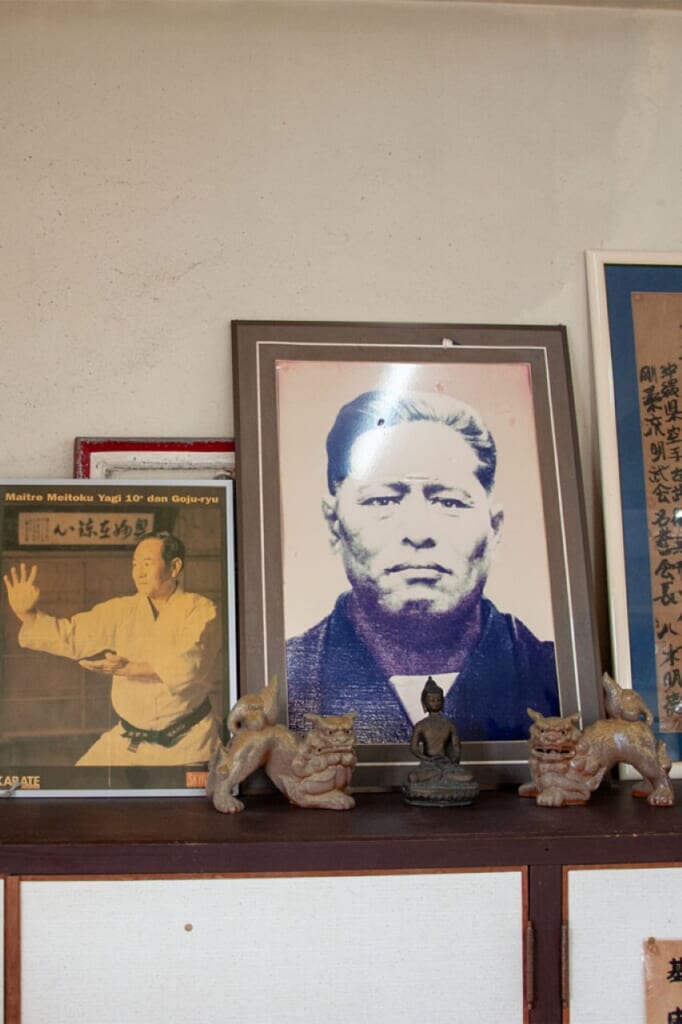
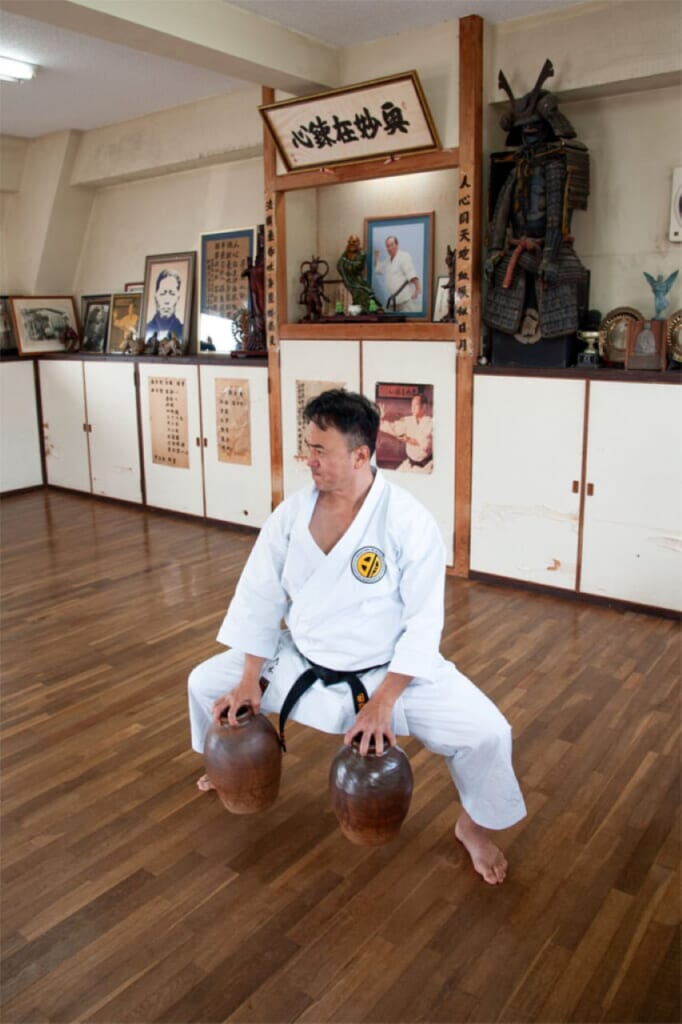
Akihito told me that he spends around five hours a day at the dojo, either practicing or teaching karate. For my inaugural lesson, Akihito gently walked me through several basic aspects of karate training, including blocking and punch moves and simple kicks. The basis of each move that Akihito demonstrates is focussed on disarming an attack through self defence first, followed by a move to disable the attacker. Despite the global popularity of karate, Akihito is keen to stress that karate is not a sport but an art, as well as a vital part of Okinawan culture.
Rustling Up a Feast of Local Cuisine in a Yakuzen Ryuka Cooking Experience
From Yagi Dojo I headed north to the city of Urama to take part in another distinctly Okinawan experience. In Uruma I met Yukie Miyaguni, a nutritionist and cook who teaches all about the medicinal and health benefits of traditional Ryukyu cuisine.
Okinawa has become famous for the longevity of its population. Okinawa has one of the highest life-expectancy rates in the world, and a large percentage of Okinawans live active lives well beyond the age of 90. In her cookery classes Yukie, explains the many health benefits of traditional Ryukyu cuisine and how many staple ingredients of Okinawan dishes play a vital role in helping Okinawans to live to such a grand old age.
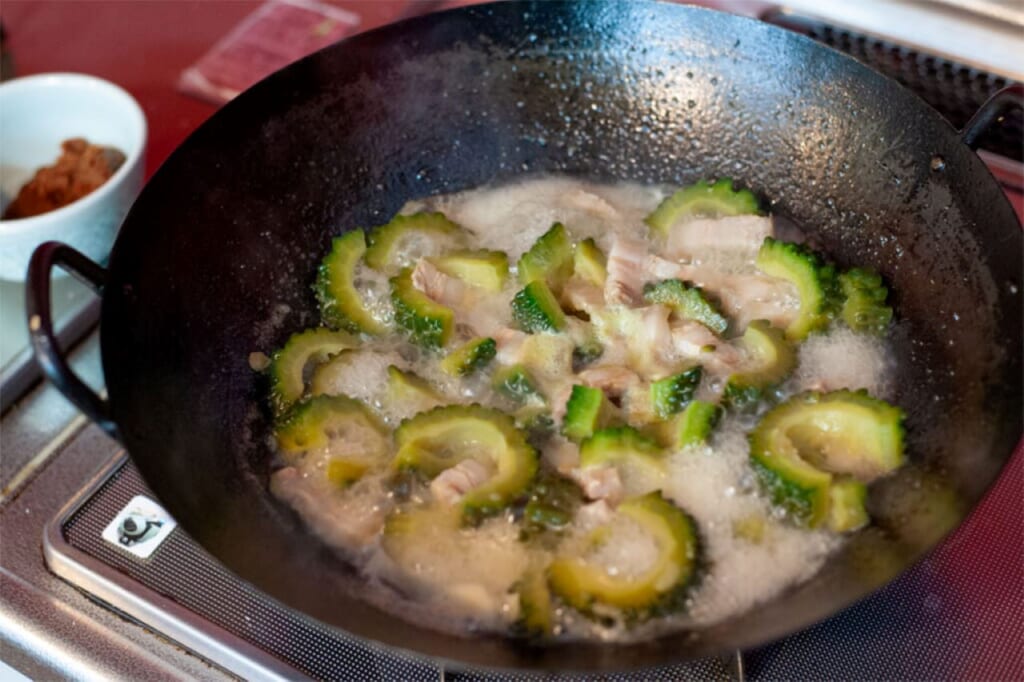
I met Yukie at Ura Marche, a supermarket that specializes in local Okinawan produce, where we selected ingredients for the meal we would later cook in her kitchen. Amongst an impressive selection of seasonal fayre we picked out a bitter melon – a staple of Ryukyu cooking – as well as a bag of tofu that was so fresh it was still hot. Also added to the basket was a tub of rich miso paste.
In Yukie’s kitchen I was quickly put to work chopping up the bitter melon, breaking the tofu into chunks and slicing a healthy slab of pork belly into thin strips. These are all placed into a large wok on the stove, together with a bone broth and dashi, as well as a generous scoop of the miso paste.
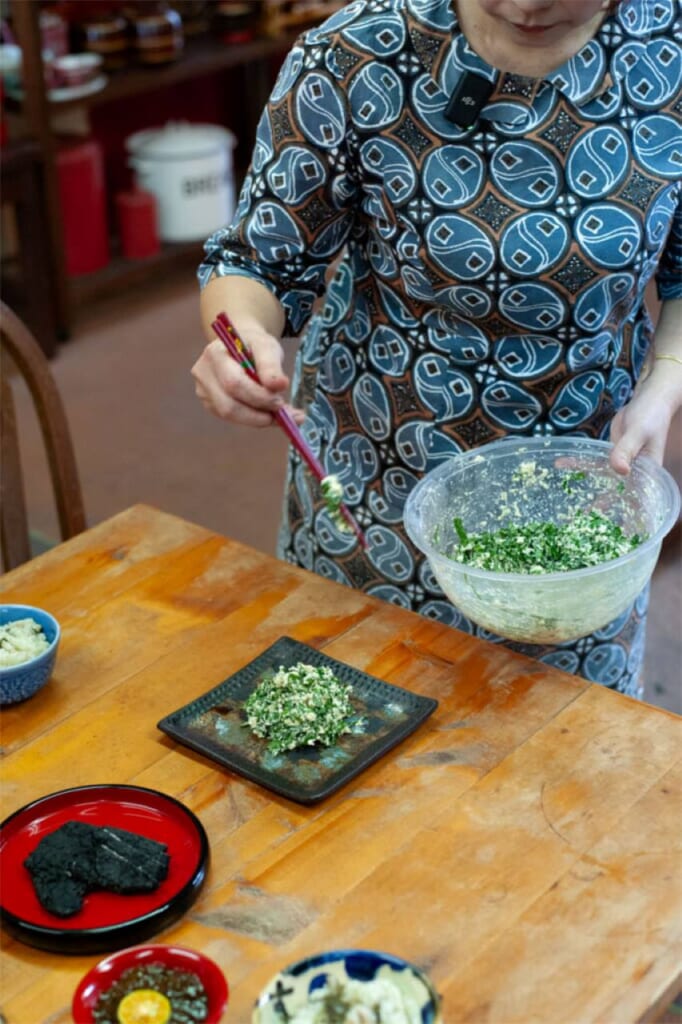
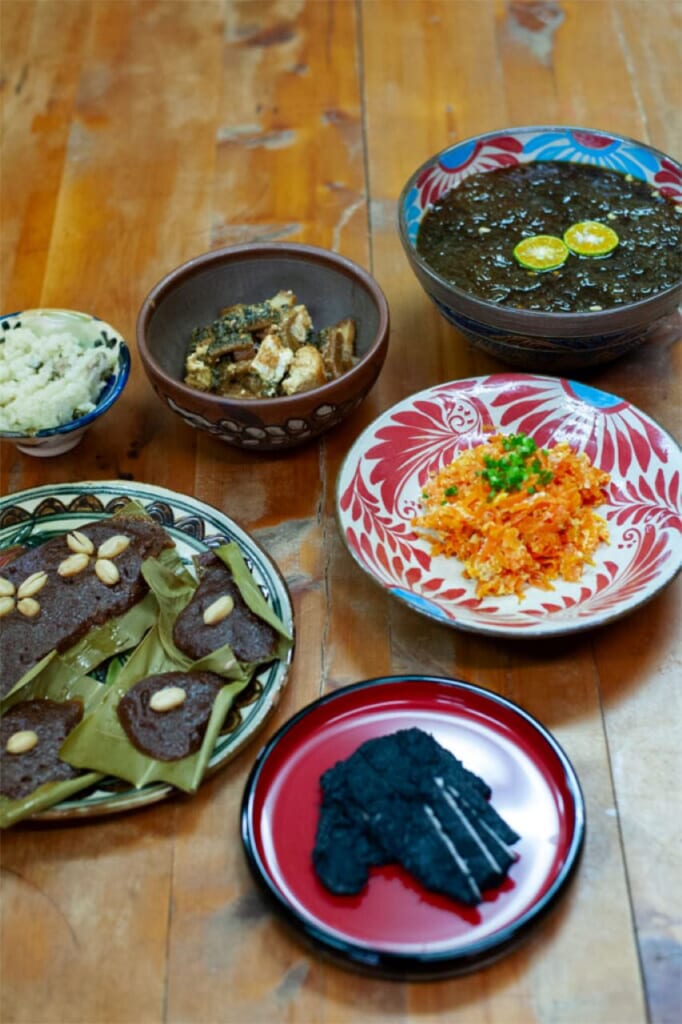
In recent years Okinawan food culture has received a great deal of international attention as many people have tried to discover the secrets of traditional Ryukyu cuisine and learn how to live a long and productive life. Okinawan cuisine uses many local ingredients, including a range of vegetables, such as bitter melon, sweet potato, daikon, kelp, and sea cucumber. Typically low in protein, fat, and calories, Okinawan cuisine is packed with plenty of nutrients, as well as fiber and antioxidants. Together, Yuki and I created a wonderful mix of dishes and accompaniments to produce an absolute feast, each healthy and nutritious and bursting with flavor.
Visiting the Zakimi Castle Ruins
On my way to the north of the island I stopped to see the ruins of Zakimi Castle (座喜味城跡), another of the locations that make up Okinawa’s UNESCO World Heritage site. Zakimi Castle was originally built in the 15th century to to monitor enemy activity. Though the castle building has long been lost, the impressive stone wall fortifications remain.
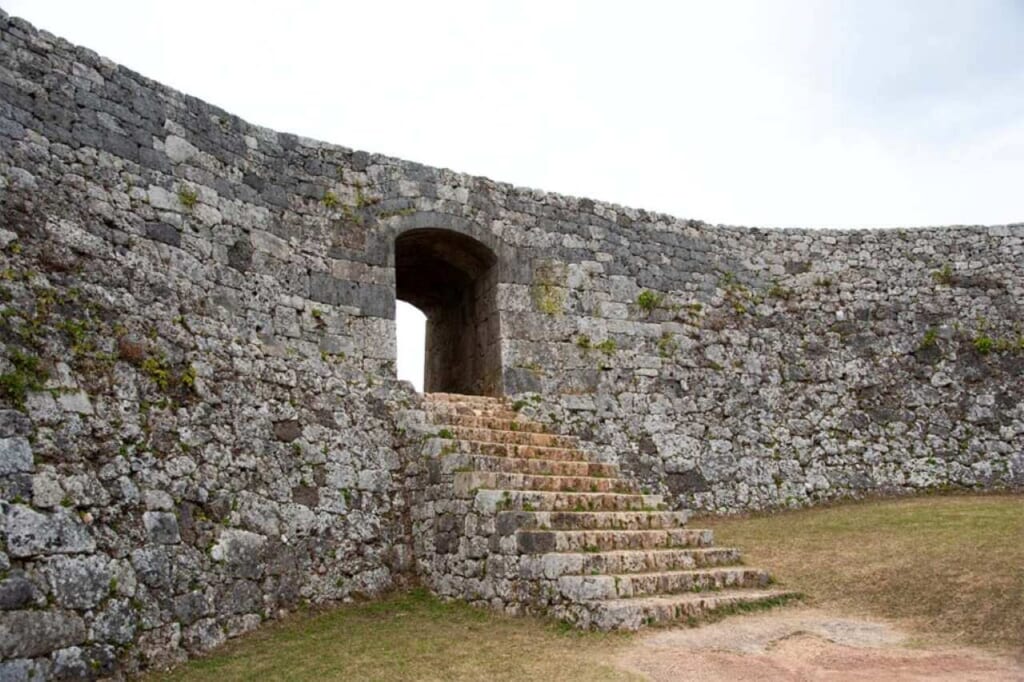
Similar to the castle walls at Shurijo Castle Park, the fortification walls at Zakimi Castle are curved over a sloping hilltop. Zakimi Castle’s fortifications also feature a number of advanced masonry techniques that today seem ahead of their time. Many of the fortification’s large stones have been cut to specific shapes so that they are easier to stack together, making them much more stable and the reason that they’re still standing today.
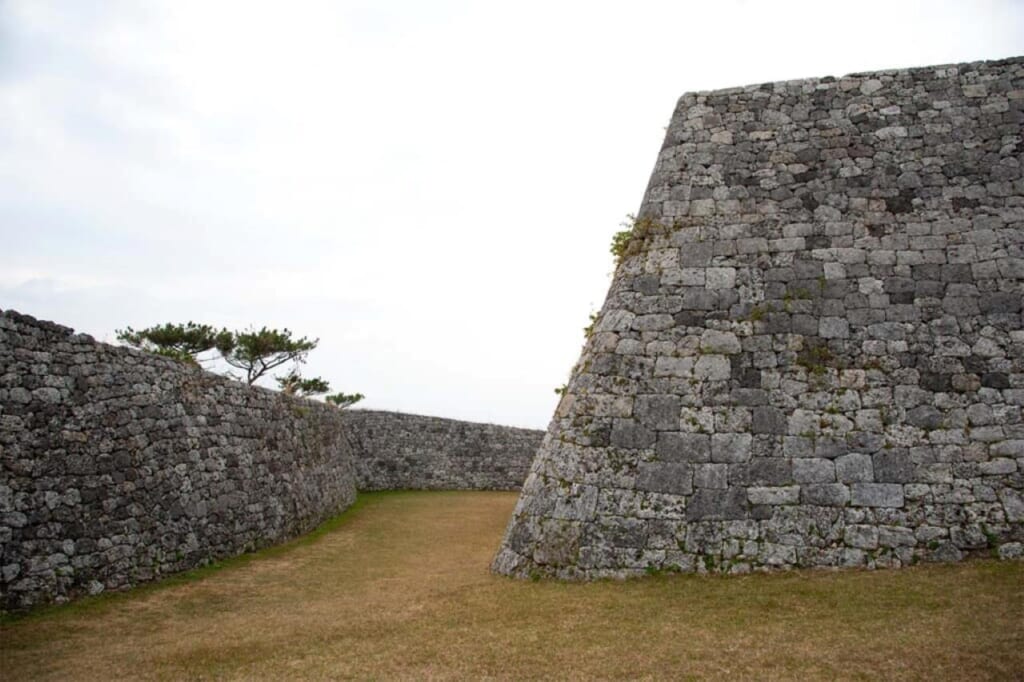
Another inventive example of Ryukyuan masonry techniques is the positioning of a small wedge used to build the castle’s archways, which are the oldest still in existence in Okinawa.
Checking in at the Okuma Private Beach and Resort
That night I continued north to my accommodation for the night at the Okuma Private Beach and Resort. Okuma Private Beach and Resort has a host of different types of accommodation available, including spacious and comfortable suites, villas and cottages that can sleep up to 7 guests.
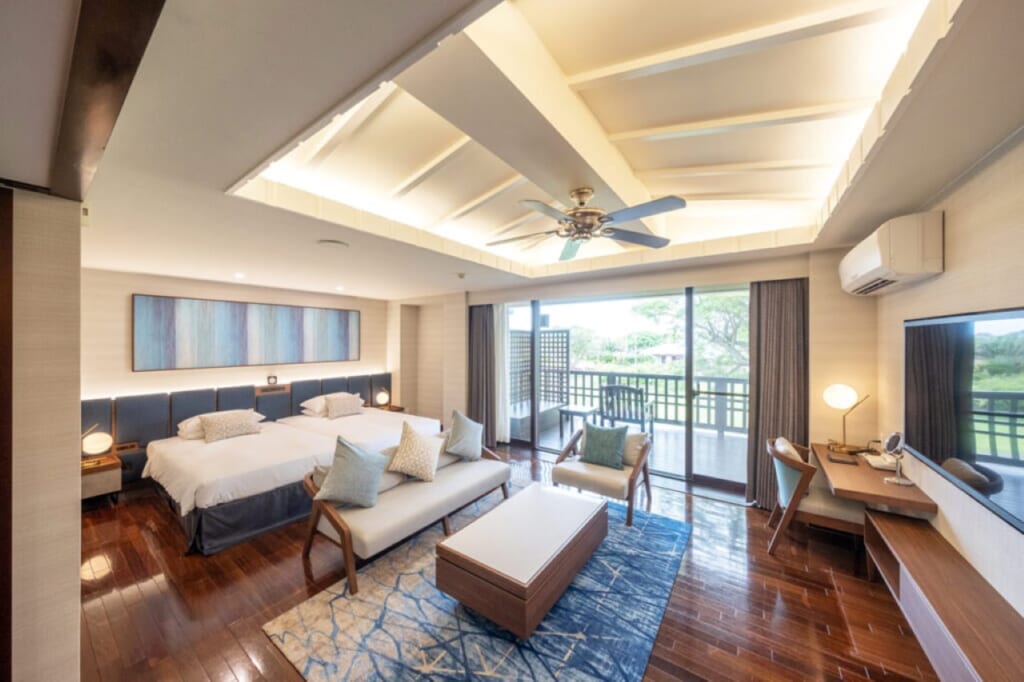
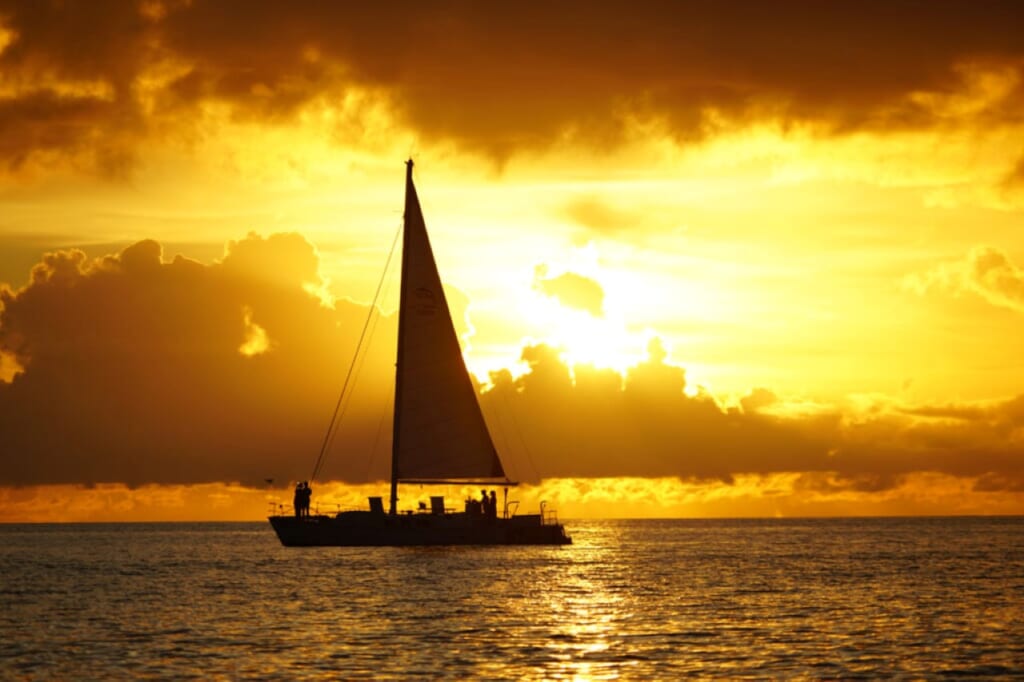
Facilities include a public bath with a view of the sea, a sauna, outdoor pools, an aromatherapy salon and of course the hotel’s own private beach. From the beach you can enjoy spectacular views of the setting sun in the late afternoon. There are six restaurants (including summer openings), making this the perfect place to kick back and relax, or for exploring the Yambaru National Park.
Day 5 – A Morning Hike to Hiji Otaki Falls
I was up early the next morning to visit the Hiji Otaki Falls (比地大滝) in the Yambaru National Park. The Yambaru National Park covers the majority of northern Okinawa island and is home to a thick subtropical broadleaf forest and a rich and diverse range of wildlife. Many species of birds live in the Yambaru National Park, including the endemic Okinawa rail and the Okinawa woodpecker. In recognition of its unique environment, Yambaru National Park was registered as a World Natural Heritage site in 2021.
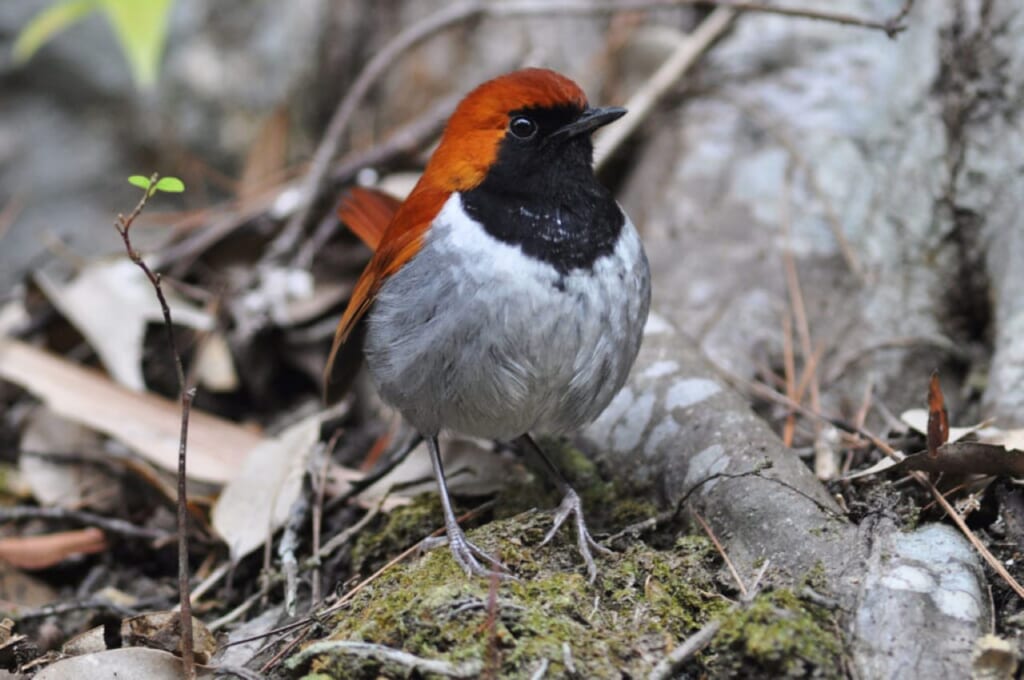
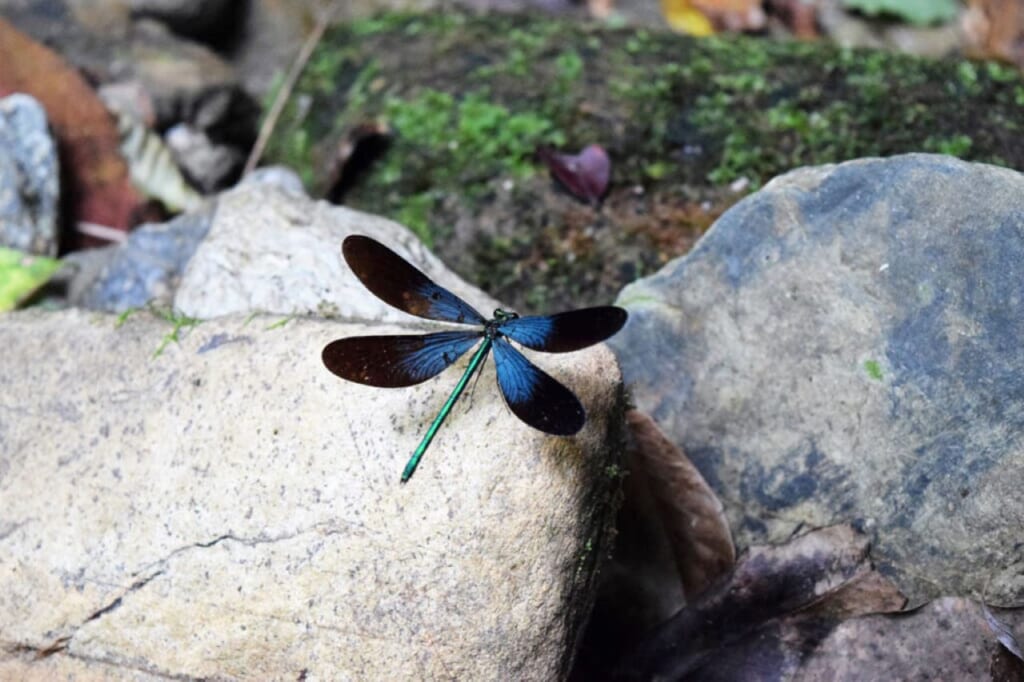
It’s a relatively easy three-kilometer round trip hike to Hiji Otaki Falls. At 26 meters high, Hiji Otaki Falls is the largest waterfall on the island. My hike was led by Kenji and Riko, two local nature guides who are a fountain of knowledge on the forest’s biodiversity. As a precaution, Kenji and Riko insist that we carry bamboo sticks on the hike because of the need to identify poisonous snakes whose habitat is the forest.
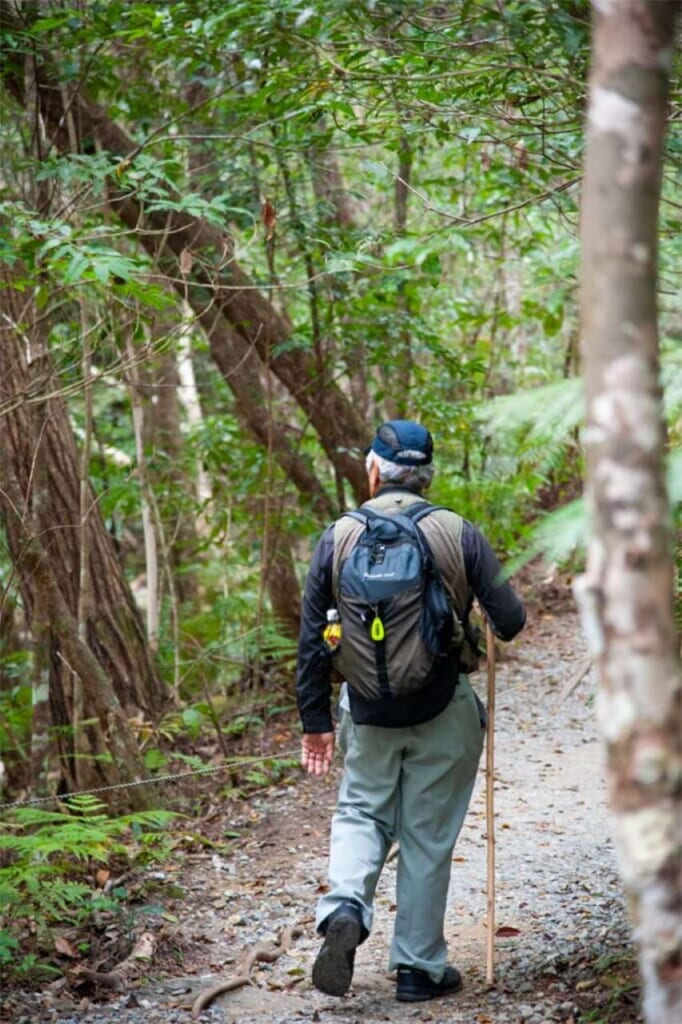
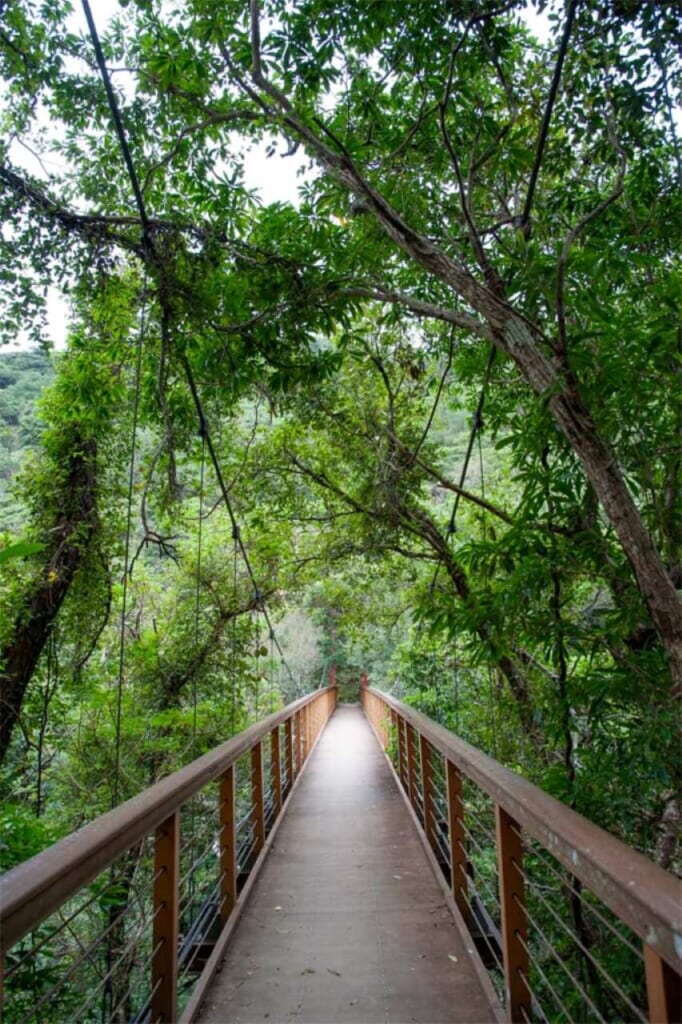
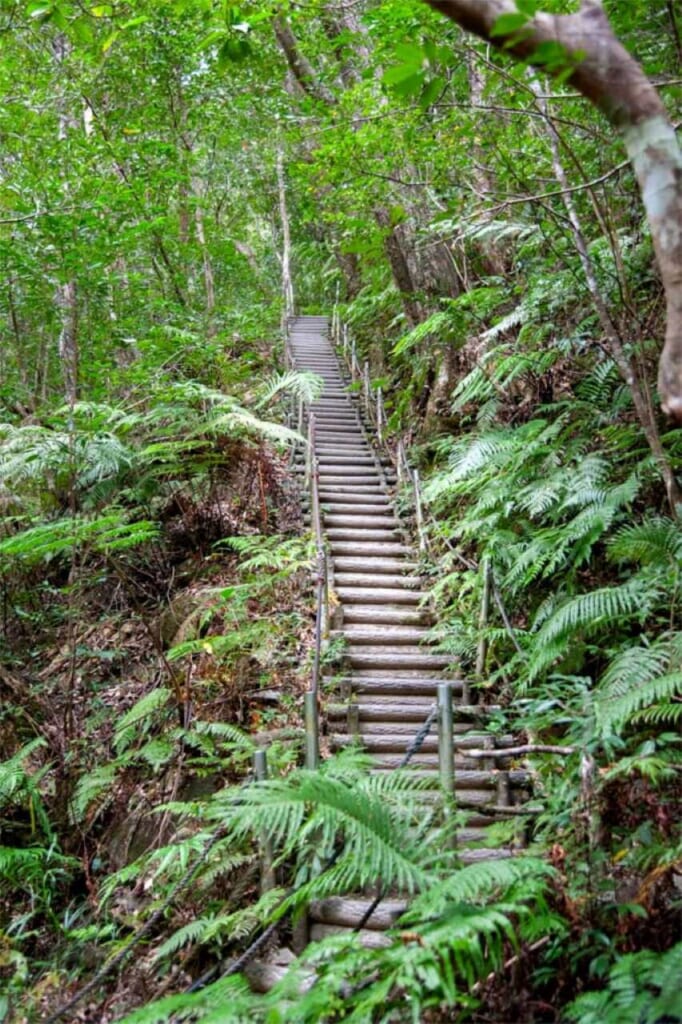
During the hike, Kenji and Riko explain more about the Yambaru National Park’s flora and fauna. On the way to Hiji Otaki Falls we stop to admire the forest’s giant oak trees, the curling branches of the flying spider-monkey tree ferns and to listen to the birdsong of the Okinawa rail.
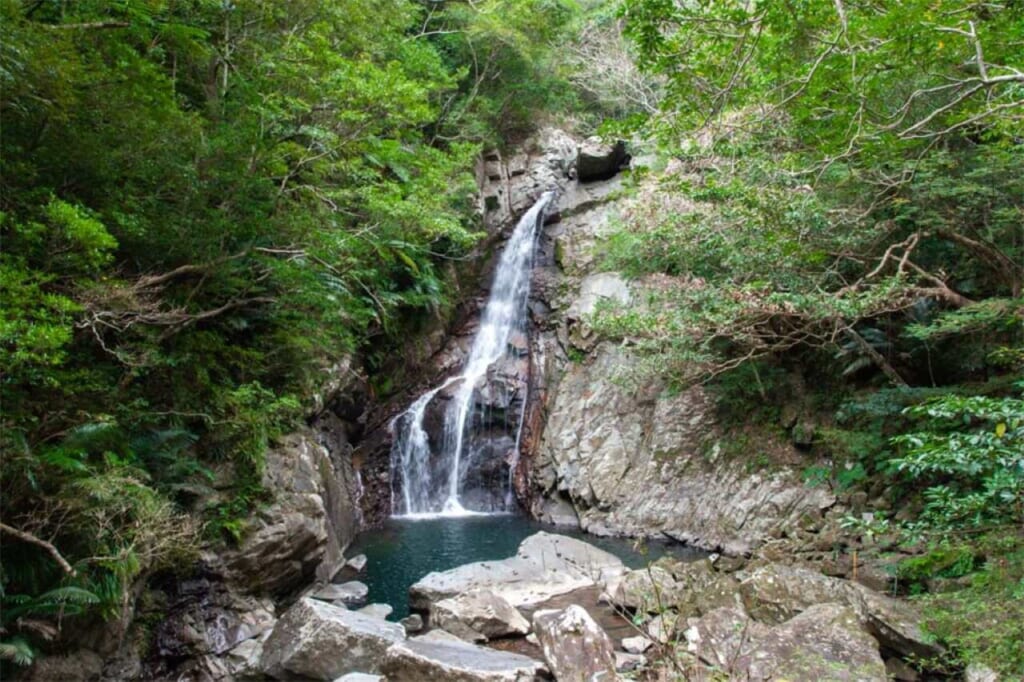
At the end of the trail is the majestic Hiji Otaki Falls, which flows into a calm pool of water that’s surrounded by a bed of giant rocks. Kenji and Riko brought out flasks of hot coffee and sweet rice cakes filled with red bean paste called daifuku mochi for sustenance before we made the return trek back. A truly awe-inspiring sight, Hiji Otaki Falls marked a fitting end to my time in Okinawa. When visiting Yambaru National Park please be environmentally conscious in order to protect the rare plants and animals that inhabit this land.
How to Fly the Happy Route From Canada to Tokyo and Okinawa
You can find the best deals on direct flights to Tokyo from Canada with Air Canada. Flights from Tokyo’s Haneda Airport to Naha Airport take just under three hours and can be booked with ANA. You can also use ANA’s Japan Travel Planner to discover more wonderful destinations in Japan and to help you prepare for your trip to Japan.
Article sponsored by and photographs courtesy of Okinawa Convention & Visitors Bureau and Tokyo Convention & Visitors Bureau.



